
-
First Honeymoon shipment bound for Europe


Source: https://www.world-nuclear-news.org/Articles/First-Honeymoon-shipment-bound-for-Europe
Boss Energy is set to make its first delivery of uranium since restarting the project in South Australia after a decade under care-and-maintenance.
The project is still in the commissioning and ramp-up phase - it produced its first post-restart drum of uranium in April - and the ramp-up is running ahead of schedule, the company said. By the end of June, it had produced 57,364 pounds U3O8 (22 tU). With one NIMCIX ion exchange column performing to expectations, and construction of two further columns progressing on track, the company said it expects production to total at least 850,000 pounds U3O8 by the end of June 2025.
"The start-up phase at Honeymoon is proceeding comfortably to plan, with all the key metrics running in line with, or exceeding, the forecasts contained in the Feasibility Study schedule," Boss Managing Director Duncan Craib said. "Construction of the second and third columns is also advancing well, ensuring we are on track to continue increasing our production rates. Total production in FY26 is set to meet or exceed our feasibility study forecasts at 1.63 Mlb. The addition of columns 4, 5 and 6 are forecast to further increase the production rate to nameplate capacity of 2.45 Mlb/annum by year three."
Honeymoon first began operations in 2011 but was put on care-and-maintenance in 2013 by its then-owner Uranium One. It was acquired by Boss in 2015. Boss's board approved a final investment decision to restart operations in June 2022. Mining activities restarted last year.
The company said it will now make its first delivery to European nuclear utilities under its existing sales contracts, with revenue to be received in the current quarter.
-
EC approves completion of Romanian reactors

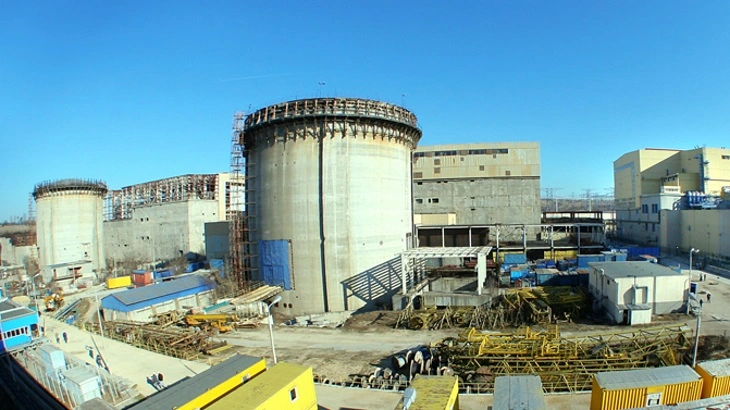
Source: https://www.world-nuclear-news.org/Articles/EC-approves-completion-of-Romanian-reactors
The European Commission has issued a positive opinion on the technical and nuclear safety aspects of the construction of units 3 and 4 at Cernavoda nuclear power plant in Romania. Unit 3 is scheduled to start commercial operation in 2030 and unit 4 the following year.
Under the Euratom Treaty, nuclear project developers are required to notify the European Commission of planned investments and to demonstrate compliance with the highest nuclear safety standards.
Energonuclear - a wholly owned subsidiary of utility Nuclearelectrica - notified the Commission about the planned construction of two Canadian-designed Candu-6 pressurised heavy water reactors as Cernavoda 3 and 4 in May 2023.
The positive opinion received from the Commission "is the result of an elaborate analysis of the information provided by the Romanian side, visits to the Cernavoda site and technical discussions over a period of 13 months", Nuclearelectrica noted. "The Commission's assessment is that the project to complete the construction of units 3 and 4 at Cernavoda is in line with the objectives of the Euratom Treaty.
"This positive view is accompanied by the usual recommendations for such projects, which aim at the appropriate application of the Euratom framework in the implementation and during the lifetime of the project. These recommendations will be implemented by the project developer in the next steps."
Nuclearelectrica CEO Cosmin Ghita added: "The adoption of the positive view of the European Commission is a confirmation of our commitment to technical excellence and nuclear safety. We are delighted with this significant progress and we are confident that the project of units 3 and 4 at Cernavoda will make a decisive contribution to Romania’s energy security and sustainability."
The EC's positive opinion was also welcomed by Romanian Minister of Energy Sebastian Burduja. "Today the European Commission confirms our progress and the construction of the two new reactors moves to the next stage," he said. "Reactors 3 and 4 represent key pillars of the national energy strategy, the two units will make an essential contribution in ensuring energy security at national and regional level. We are talking about production in the clean energy band, with zero emissions. Our country needs big projects, and Romania's expertise in nuclear engineering makes us responsible for carrying on the tradition of 40 years of safe technology."
Cernavoda is the only nuclear power plant in Romania and consists of two 650 MWe Candu-6 reactors. Unit 1 went into commercial operation in 1996 and unit 2 in 2007. Operator Nuclearelectrica plans to extend the operating life of unit 1 to 60 years. Most of the work on units 3 and 4 was done in the 1980s prior to the fall of the government of Nicolae Ceausescu in 1989.
In October 2022, Romania said Canada and the USA were both offering to help with the financing of the construction of Cernavoda 3 and 4, which has an estimated cost of EUR7 billion (USD7.4 billion).
Romania's government adopted a law in March last year approving a support agreement with Nuclearelectrica for the proposed units. The commitments given by the law include the government taking "the necessary steps to finance the construction of the two reactors, including but not limited to the granting of state guarantees to the project's financiers". It will also be responsible for the implementation of the "Contracts for Difference" support mechanism.
-
Novel transistor material shows nuclear potential


Source: https://www.world-nuclear-news.org/Articles/Novel-transistor-material-shows-nuclear-potential
Gallium nitride semiconductors can successfully withstand the harsh environment near a nuclear reactor core, researchers from Oak Ridge National Laboratory (ORNL) have found. The discovery could enable electronic components to be placed closer to sensors in an operating reactor leading to more precise and accurate measurements with safety and operational benefits.
Sensors are used to gather information from a reactor and can identify potential equipment failures before they happen, helping prevent costly unscheduled shutdowns. But the complex circuitry the sensors are connected to must be placed away from the reactor core to protect the electronics from heat and radiation. The long cables used to transmit data from the sensors via can pick up additional noise and degrade the signal.
Gallium nitride is a so-called wide-bandgap semiconductor that is more resistant to heat and radiation than silicon, and is commercially available, although not currently widely used. Researchers from the US Department of Energy lab tested its properties by placing gallium nitride transistors close to a research reactor core at The Ohio State University where they successfully withstood high heat and radiation for three consecutive days. The transistors were able to handle a 100 times higher accumulated dose of radiation than standard silicon devices at a sustained temperature of 125°C, performing beyond expectations.
"We fully expected to kill the transistors on the third day, and they survived," said lead researcher Kyle Reed, a member of the Sensors and Electronics group at ORNL, adding that the work makes measuring the conditions inside an operating nuclear reactor "more robust and accurate".
By exposing the transistors to days of high radiation levels in the reactor core itself, the researchers were able to conclude that gallium nitride transistors are capable of surviving at least five years in a reactor, the normal maintenance window for such components.
The research may also be important for advanced microreactors, which due to their compact size will need sensors capable of withstanding more adverse radiation conditions than currently operating reactors. However, the testing at Ohio State University showed that heat was more harmful to gallium nitride than radiation. The researchers are now working to further understand the heat effects.
Better nuclear monitoring means increased safety and reduced operating costs, and reducing the frequency of maintenance outages reduces human safety risks, Dianne Ezell, leader of ORNL’s Nuclear and Extreme Environment Measurements group, said. "Hundreds of thousands of dollars are lost every day a reactor is shut down," she said. "If we're going to make nuclear economically competitive with other energy industries, we've got to keep our costs low," she said. "You're able to avoid putting people in harsh radiation environments or handling radioactive material as often," she added.
- www.euractiv.com EU Commission clears Romania's plans to build two new nuclear reactors
The European Commission has issued a positive opinion on the technical and nuclear safety aspects of the project for units 3 and 4 of Romania's only nuclear power plant, the Romanian Energy Ministry announced on Tuesday.
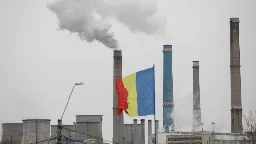
The European Commission has issued a positive opinion on the technical and nuclear safety aspects of the project for units 3 and 4 of Romania’s only nuclear power plant, the Romanian Energy Ministry announced on Tuesday.
With the Commission’s green light, the plant, managed by the country’s sole nuclear power producer, the state-owned Nuclear Electric Company, and located in the southeastern town of Cernavodă, will receive two additional CANDU reactors.
Energy Minister Sebastian Burduja said on Tuesday that the two new reactors are expected to “make an essential contribution to national and regional energy security by producing clean, zero-emission energy.”
The Commission’s opinion confirms that the project is in line with the objectives of the Euratom Treaty, which requires nuclear developers to notify the Commission in advance of investment projects and demonstrate compliance with the highest nuclear safety standards. It also contains several recommendations typical of such projects.
With four nuclear units soon to be operating, Romania is expected to avoid 20 million tonnes of CO2 emissions per year and create more than 19,000 jobs in related industries.
Once the two units come on stream, Romania’s electricity mix will change significantly, with nuclear power expected to account for around 30% of the country’s electricity production over the next decade, up from about 20%, the Nuclear Electric Company added.
-
EDF to modify Nuward design to aid commercialisation


Source: https://www.world-nuclear-news.org/Articles/EDF-to-modify-Nuward-design-to-aid-commercialisati
France's EDF plans to optimise the design of its Nuward small modular reactor design, focusing on existing and proven technologies. The move follows feedback from potential European customers in order to guarantee that project deadlines and budgets are met.
The Nuward project was launched in September 2019 by the French Alternative Energies and Atomic Energy Commission, EDF, Naval Group and TechnicAtome. The Nuward - consisting of a 340 MWe SMR plant with two pressurised water reactors (PWRs) of 170 MWe each - has been jointly developed using France's experience in PWRs. The technology is expected to replace old high CO2-emitting coal, oil and gas plants around the world and support other applications such as hydrogen production, urban and district heating or desalination.
The Nuward SMR project has now reached the basic design phase, during which the engineering teams were able to progress on the lay-out, systems and equipment of the power plant in more detail.
"Considering the evolving SMR market dynamics and the learnings drawn from the development of Nuward SMR, the EDF Group has proactively decided to pivot its SMR product strategy," EDF said in a statement. "To address the needs expressed by the market timely and competitively, the EDF Group has decided to shift its product strategy towards the development of a design based on proven technology bricks only. This orientation will provide better conditions for success by facilitating technical feasibility."
EDF said that, together with its Nuward subsidiary, it is now "preparing the conditions for a product development leveraging the extensive technical, industrial and commercial experience cumulated so far". It said it will rely on its experience in nuclear and PWR technology.
According to Nuward's previously announced SMR roadmap, the detailed design and formal application for a new nuclear facility is scheduled to begin in 2026, followed by first concrete in France in 2030 with the construction of that first unit anticipated to take about three years.
EDF did not say whether the redesign of the reactor's design would have an impact on the Nuward project's budget and timeline. It issued its statement in response to media reports that had incorrectly stated the company was dropping or suspending the project.
In June 2022, EDF announced that the Nuward design would be the case study for a European early joint regulatory review led by France's Autorité de Sûreté Nucléaire with the participation of Finland's Radiation and Nuclear Safety Authority and the Czech State Office for Nuclear Safety.
The main objectives of the multilateral review were to identify key issues towards the hypothetical licensing of a Nuward SMR in the three countries, and to identify divergences and convergences between the regulatory frameworks in these countries - it was not intended to replace any future licensing review of any participating regulator.
Three more regulator - Poland's National Atomic Energy Agency, the Swedish Radiation Safety Authority and the Netherlands' Authority for Nuclear Safety and Radiation Protection - joined the second phase of the review.
-
International team reviews Uganda's uranium exploration plans

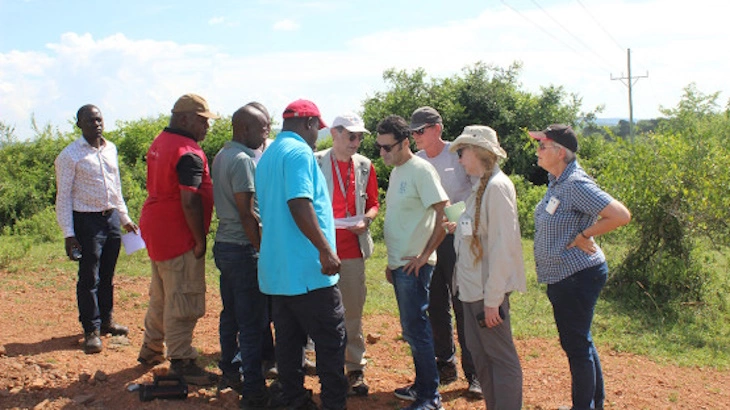
Source: https://www.world-nuclear-news.org/Articles/International-team-reviews-Uganda-s-uranium-explor
The team of experts assessed Uganda's capabilities to develop a uranium exploration programme and eventually to mine uranium for a domestic nuclear power programme.
The International Atomic Energy Agency (IAEA)-led Integrated Uranium Production Cycle Review (IUPCR) mission, conducted with the support of the IAEA's technical cooperation programme, evaluated the status of the infrastructure Uganda will need to support uranium exploration as the first phase of a uranium production cycle programme. It was carried out at the request of the Ugandan government.
The team of experts from Argentina, Australia, France, Namibia and the IAEA reviewed 16 key aspects, including human resource capacity and the regulatory framework, and recommended steps that can be taken to bring Uganda closer to realising its nuclear energy goals, which include a domestic supply of uranium. Eighty-two participants, mainly from Uganda’s Ministry of Energy and Mineral Development, were involved in mission activities.
Only about half of Ugandans currently have access to electricity. The government has set a goal of achieving an electricity access rate of more than 99% by 2030, and is aiming for nuclear power generation by 2031, with the help of domestically sourced uranium.
IUPCR missions form part of the IAEA's Milestones Approach for countries that are newcomers to nuclear energy. The missions assist IAEA member countries in the development of infrastructure for national uranium production programmes, through all phases of the uranium production cycle. The Agency said this was the first mission of its kind.
Several areas in Uganda have been identified as potentially uranium-rich, though no proven resources are currently known.
"The potential discovery of a uranium deposit and subsequent development of uranium resources in Uganda presents an exciting opportunity for the country to support its ambition to introduce nuclear power into its energy mix," said Adrienne Hanly, the IAEA's Technical Lead for Uranium Resources and Production. "While significant work remains to be done, the Ministry of Energy and Mineral Development now has a solid understanding of what is required to succeed in evaluation of the country’s uranium occurrences and the next steps needed to get there."
The IUPCR team recommended that Uganda should ensure the development of skilled personnel for uranium exploration and establish a robust and well-funded exploration programme to accelerate the discovery, assessment and development of potential uranium resources.
"The government of Uganda is committed to adopting international best practices and this IAEA mission will ensure uranium exploration is done according to international standards," Minister of Energy and Mineral Development Ruth Nakabirwa Sentamu said.
-
Korean city to study feasibility of i-SMR deployment

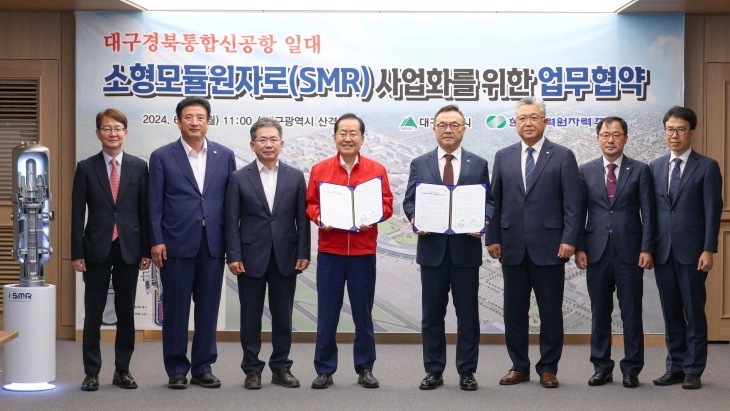
Source: https://www.world-nuclear-news.org/Articles/Korean-city-to-study-feasibility-of-i-SMR-deployme
Korea Hydro & Nuclear Power (KHNP) has signed a memorandum of understanding with Daegu Metropolitan City for the construction of a small modular reactor power plant at a high-tech industrial complex near Daegu-Gyeongbuk New Airport.
The MoU was signed on 17 June at Daegu City Hall by Daegu Mayor Hong Joon-pyo and KHNP CEO Whang Joo-ho. The MoU includes a feasibility study covering site suitability, economic viability, and enhancing resident acceptance, in a bid to build and commercialise a 680 MWe SMR power plant equivalent to the capacity of four 170 MW-per-unit modules.
Daegu City, in North Gyeongsang Province, said it plans to conduct a preliminary feasibility study with KHNP and private construction companies by 2026, obtain standard design approval from the government in 2028, and begin commercial development in 2033.
To this end, a newly-created SMR construction special purpose corporation (SPC) will purchase about 160,000 square metres of land out in the Gunwi Advanced Industrial Complex and proceed with construction. The total project cost of KRW4 trillion (USD2.9 billion) will be entirely financed by the SPC.
On 31 May, the Ministry of Trade, Industry and Energy (MOTIE) allocated 0.7 GWe for SMRs by 2035 through the 11th Basic Plan for Electricity Supply and Demand. It announced a specific scheme to introduce one unit consisting of four 170 MWe modules.
"This agreement is the first case since the introduction of the first SMR in the 11th basic power plan was announced in May, and this is the first time that a metropolitan government has directly started SMR construction," Daegu City noted.
The city said it has been discussing with MOTIE, the Korea Atomic Energy Research Institute and i-SMR Technology Development Agency for the past two years to build the first SMR in South Korea at the Gunwi New Airport Advanced Industrial Complex.
Daegu Metropolitan City said it plans to build an "SMR industrial ecosystem" by attracting power-intensive industries such as AI semiconductors and data centres to the new airport high-tech industrial complex, and will also prepare various support measures such as supplying district heating to parts of Daegu, increasing local income, resident welfare, and subsidising electricity rates.
The Korean-designed i-SMR is an integrated pressurised water reactor type nuclear power plant with an electrical output of 170 MWe. It is being developed according to a development roadmap, with the goal of completing the standard design by the end of 2025 and obtaining standard design approval in 2028. According to KHNP, it requires just one-third of the investment, and can be constructed in half the time compared with large reactors.
KHNP has already signed a memorandum of understanding with Nusantara Power - a power generation subsidiary of Indonesian Electric Power Corporation - on mutual cooperation for the introduction and construction of the i-SMR in Indonesia. Through this MoU, the two companies will cooperate in various fields, including: joint basic research on the economic feasibility and technology for deployment of the i-SMR in Indonesia; development of local specialised technology through R&D cooperation; and collaboration through human/technology exchanges in the nuclear field through the formation of a working group.
KHNP has also signed an MoU on mutual cooperation with the Jordan Atomic Energy Commission for the deployment of the i-SMR in Jordan. The two organisations agreed to cooperate in comprehensive technology and information exchange on the i-SMR and to jointly conduct a feasibility study. Jordan is currently considering the introduction of SMRs after 2030 in preparation of expected increased electricity demand.
-
Testing complete at molten salt demo

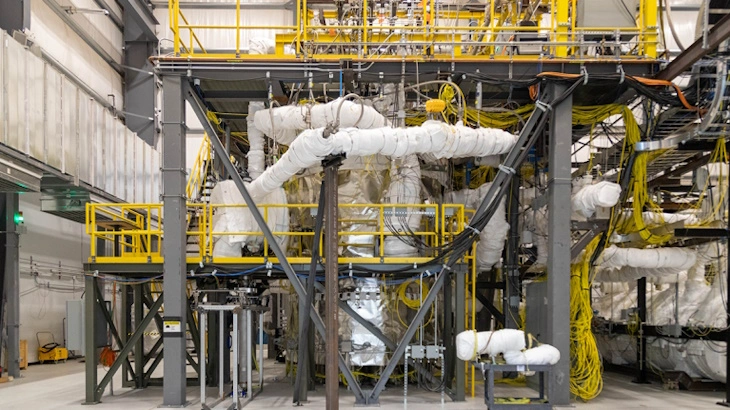
Source: https://www.world-nuclear-news.org/Articles/Testing-complete-at-molten-salt-demo
The first iteration of an engineering test system for Kairos Power's Hermes low-power reactor, is now being decommissioned after more than 2,000 hours of pumped salt operations. Construction of the next iteration - which will demonstrate the modular design of the reactor - is already under way.
Engineering Test Unit (ETU 1.0) is the first of three systems that are being built to inform the design, construction, and operation of Hermes, which will advance the development of Kairos's fluoride salt-cooled high-temperature reactor (KP-FHR) technology. Hermes, which is being supported by the US Department of Energy's Advanced Reactor Demonstration Program (ARDP), will use a TRISO fuel pebble bed design with a molten fluoride salt coolant to achieve a thermal power level of 35 megawatts.
ETU 1.0 is the first in a series of multiple prototypes that are being designed and built as part of Kairos' "rapid iterative development". A full-scale, electrically heated prototype of Hermes, ETU 1.0 served as a vehicle for Kairos Power to exercise the supply chain and establish new capabilities, including the production of high-purity fluoride-lithium-beryllium salt coolant known as FLiBe, and specialised reactor components.
ETU 1.0, at Albuquerque, New Mexico, started operations in December 2023. Using 12 tonnes of FLiBe produced by Kairos in partnership with Materion Corporation at its Molten Salt Purification Plant in Elmore, Ohio, the system was filled with 30,000 surrogate fuel pebbles and more than 300 graphite reflector blocks to replicate conditions inside the Hermes reactor core. Over six months, it carried out more than 2000 hours of pumped salt operations including regular operation and tests designed to simulate failure scenarios. At its peak, the system reached 675°C and a salt flow rate of 3000 gallons (more than 11,300 litres) per minute.
The test unit was monitored around the clock, providing more than 10 terabytes of performance data in addition to information from the analysis of salt samples and inspections of 1673 surrogate fuel pebbles.
"With our iterative approach, Kairos Power aims to learn by building, and we’ve learned a tremendous amount from building and operating ETU," said Edward Blandford, Kairos Power Chief Technology Officer and co-founder.
The next iteration - ETU 2.0 - is being built in Albuquerque. ETU 3.0 will be built in Oak Ridge, Tennessee, adjacent to the site where the Hermes reactor will eventually be built. Kairos Power plans to have the reactor, which will lay the groundwork for commercialising the 140 MWe KP-FHR, operational as early as 2026.
- www.nucnet.org El Dabaa / Russia Delivers Core Catcher For Unit 3 At Egypt Nuclear Station
Moscow is supplying Cairo with four Generation III+ plants
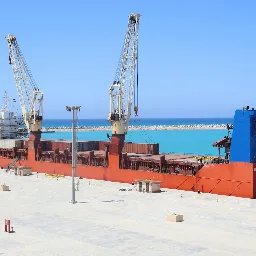
Russia has delivered the core catcher for Unit 3 of the El Dabaa nuclear power station under construction in Egypt, the main contractor, Russia’s state nuclear corporation Rosatom said.
The core catcher – also known as a core melt localisation device or core trap – is designed to catch the molten core material, or corium, of a nuclear reactor in the event of a nuclear meltdown and to prevent it from escaping the containment.
The component is among the largest in a nuclear reactor system, weighing about 170 tonnes and with a height and diameter around six metres. Rosatom said the core catcher is the first large component to be delivered onsite in Egypt.
Rosatom said the ship carrying the core catcher left the Black Sea port of Novorossiysk at the end of June for the journey south to Egypt and arrived six days later.
El Dabaa, Egypt’s first nuclear station, will have four Russia-supplied Generation III+ VVER-1200 pressurised water reactors, with the first unit expected to be online in 2026.
-
Italy 'could get 22% of electricity from nuclear by 2050'


Source: https://www.world-nuclear-news.org/Articles/Italy-s-electricity-could-be-20-from-nuclear-by-20
Italy's Minister for Environment and Energy Security, Gilberto Pichetto Fratin, has set out the possible scale of capacity if the country decides to resume a nuclear power programme.
Fratin, pictured above, speaking at the Global Energy Transition Congress in Milan, Italy, said: "By launching Italy’s platform for sustainable nuclear power, we have started an evaluation process, of course after 2030, on the possible resumption of nuclear power in Italy. We intend to do so by implementing the new sustainable nuclear technologies currently being developed, in particular small modular fission reactors and, in the long-term, through fusion power.
"Nuclear and fusion will complement the increasing penetration of energy production from renewable sources and other low carbon solutions. We expect to be able to reach about 8 GW from nuclear power by 2050, covering more than 10% of the nation’s electricity demand. This percentage may increase to over 20-22% by fully exploiting the potential of nuclear power in our country."
Italy's government included the potential nuclear capacity - the conservative 11% of capacity option and the ambitious 16 GW/20-22% of capacity - in its National Integrated Energy and Climate Plan which was submitted to the European Commission on Monday. That document also says Italy aims to have 131 GW of power from renewables by 2030 - 79 GW solar, 28 GW wind, 19 GW hydro, 3 GW bioenergy and 1 GW from geothermal sources.
A spokesman for Italian-founded innovative reactor developer Newcleo called the announcements a "good step forward" and noted the focus was on the potential of small and advanced modular reactors and also that a key part of the Italian government's submission was that the estimated cost of achieving climate goals by including nuclear was EUR17 billion (USD18.2 billion) lower than achieving it without the contribution from nuclear.
The background
Italy operated a total of four nuclear power plants starting in the early 1960s but decided to phase out nuclear power in a referendum that followed the 1986 Chernobyl accident. It closed its last two operating plants, Caorso and Trino Vercellese, in 1990.
In late March 2011, following the Fukushima Daiichi accident, the Italian government approved a moratorium of at least one year on construction of nuclear power plants in the country, which had been looking to restart its long-abandoned nuclear programme.
The public mood has changed since then, and in May 2023, the Italian Parliament approved a motion to urge the government to consider incorporating nuclear power into the country's energy mix. In September, the first meeting was held of the National Platform for a Sustainable Nuclear, set up by the government to define a time frame for the possible resumption of nuclear energy in Italy and identify opportunities for the country's industrial chain already operating in the sector.
There are a variety of emerging plans for nuclear energy in Italy, including Edison last October announcing its ambition to construct two nuclear power plants based on EDF's SMR technology between 2030 and 2040 "if the conditions are created for its return to Italy".
-
Talen opposes objection to Susquehanna data centre plans

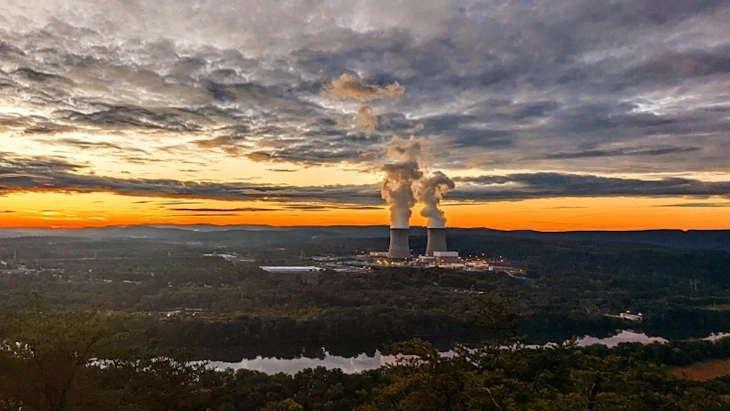
Source: https://www.world-nuclear-news.org/Articles/Talen-refutes-objection-to-Susquehanna-data-centre
A protest lodged against a precedent-setting interconnection service agreement to co-locate a data centre with a nuclear power plant is a "misguided attempt" to stifle innovation, Talen Energy Corporation said.
Exelon Corporation and American Electric Power (AEP) lodged their protest with the US Federal Energy Regulatory Commission on 24 June, saying that the regulator must either hold a hearing, or, failing that, reject the Interconnection Service Agreement (ISA) between transmission provider PJM Interconnection, Talen subsidiary Susquehanna Nuclear, operator of the Susquehanna nuclear power plant in Pennsylvania, and PPL Electric Utilities Corporation.
Earlier this year, Talen announced the sale of its 960 MW Cumulus data centre campus - which is directly connected to the two-unit Susquehanna plant - to Amazon Web Services (AWS), with a long-term agreement to provide power from Talen's Susquehanna nuclear power plant.
PJM is the regional transmission organisation that coordinates the movement of wholesale electricity in all or parts of Delaware, Illinois, Indiana, Kentucky, Maryland, Michigan, New Jersey, North Carolina, Ohio, Pennsylvania, Tennessee, Virginia, West Virginia and the District of Columbia. Its request to amend an existing Interconnection Service Agreement to increase from 300 MW to 480 MW the amount of load it is allowed to transfer from Susquehanna as "co-located load" was filed with the Federal Energy Regulatory Commission on 3 June. (Co-located load refers to end-use customer load that is physically connected to the facilities of an existing or planned customer facility at the point of interconnection to the PJM transmission system).
The amendment states that 480 MW of load may be physically transferred to a co-located load’s transmission facilities without a material impact on the transmission system, and also notes that Susquehanna has proposed modifications to allow it to physically transfer 960 MW of power.
"Too many questions of fact remain unresolved in what is, by the filing's own admission, an ISA that establishes novel configuration," Exelon and AEP say in their filing, which they say "raises more questions than it answers" and could potentially have a huge impact on customer rates, as well as raising reliability and planning concerns.
"The co-located load should not be allowed to operate as a free rider, making use of, and receiving the benefits of, a transmission system paid for by transmission ratepayers," they said. "We have no objection to co-location per se, but such load should pay its fair share of system use and other charges, just like other loads and customers."
Talen has acknowledged that its Interconnection Service Agreement is precedent-setting but also said that the protest is unfounded.
"The rapid emergence of artificial intelligence and data centres has fundamentally changed the demand for power and leads to an inflection point for the power industry," the company said. "Talen's co-location arrangement with AWS brings one solution to this new demand, on a timeline that serves the customer quickly. We believe powering the data centre economy will require an all-of-the-above approach, which includes both metered and behind-the-meter solutions.
"Exelon and AEP's protest of the Susquehanna ISA is a misguided attempt to stifle this innovation by interfering with an ISA amendment agreed to and supported by all impacted parties - which Exelon and AEP decidedly are not."
Talen goes on to say the facts cited by Exelon AEP are "demonstrably false", the legal positions are "demonstrably infirm", and "nearly all the issues raised by Exelon and AEP are not subject to Federal Energy Regulatory Commission oversight, because transmission is not implicated".
Nuclear power is increasingly being eyed by energy-intensive data centres as a means of meeting their energy demand while achieving zero-carbon objectives, whether through co-location of resources, or energy-matching deals such as last year's agreement between Constellation and Microsoft to match the energy needs of Microsoft's data centre in Boydton, Virginia, with Constellation's carbon-free energy with 35% of the environmental attributes coming from nuclear power. Earlier this year, North American steel manufacturer Nucor Corporation and US tech giants Google and Microsoft Corporation announced plans to work together across the electricity ecosystem to develop new business models and aggregate their demand for advanced clean electricity technologies, including advanced nuclear.
-
French regulatory review of Newcleo SMR progresses

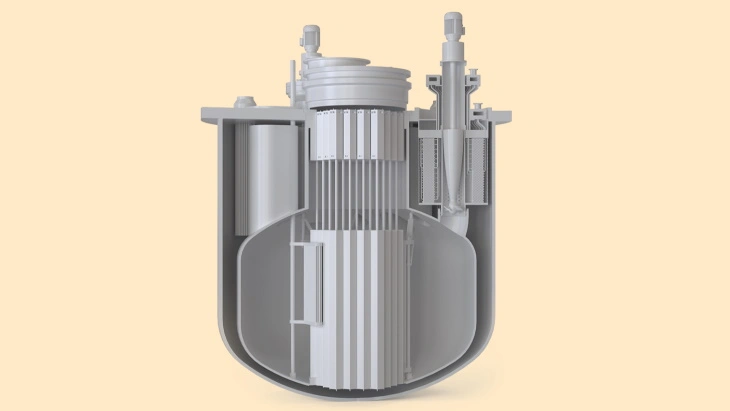
Source: https://www.world-nuclear-news.org/Articles/French-regulatory-review-of-Newcleo-SMR-progresses
Innovative reactor developer Newcleo announced it has completed the preparatory stage set up by the French authorities for developers of small modular reactor projects to facilitate, secure and accelerate the review of licence applications.
The first step of London-headquartered Newcleo's delivery roadmap will be the design and construction of the first-of-a-kind 30 MWe lead-cooled fast reactor (LFR) to be deployed in France by 2030, followed by a 200 MWe commercial unit in the UK by 2033.
At the same time, Newcleo will directly invest in a mixed uranium/plutonium oxide (MOX) plant to fuel its reactors. In June 2022, Newcleo announced it had contracted France's Orano for feasibility studies on the establishment of a MOX production plant.
Newcleo said that during the preparatory stage, the French nuclear regulator Autorité de Sûreté Nucléaire (ASN) and the Institute for Radiological Protection and Nuclear Safety (IRSN) assessed the maturity of its project and discussed all safety options for its LFR projects and the associated nuclear fuel manufacturing plant. The conclusion of this preparatory stage follows numerous technical meetings involving approximately 20 specialised experts from the authorities, as well as the development of a range of preparatory documents covering various technical topics.
The completion of the preparatory phase on 26 June will be followed by the submission of official technical options for both the LFR and the MOX manufacturing plant. The French authorities will then establish a written advice which, along with other considerations derived from the preparatory phase discussions, will allow a faster process to grant the necessary authorisation decrees to Newcleo.
"We are all thrilled that our project has reached this key milestone in the rigorous process leading Newcleo to obtain the required authorisations for the launch of this new sustainable nuclear sector," said Newcleo Global Licensing Director Stéphane Calpena. "The constructive discussions we have had with experts from the French authorities have been invaluable, enabling us to guide our design choices and associated safety requirements to meet the exceptionally high standards that French nuclear energy is known for."
In January, Newcleo announced a strategic and industrial partnership with French micro-reactor developer Naarea designed "to support all players in their industrial, technological, scientific and regulatory development" of Generation IV fast neutron reactors. The companies said that the partnership will be open to others to join and said it will focus on key areas where there are common interests, such as gaining access to the used nuclear fuel from conventional nuclear reactors that their Gen-IV reactors are designed to use as part of their efforts to close the fuel cycle.
Newcleo was a winner of the 'Innovative nuclear reactors' call for projects under the 'France 2030' investment plan implemented by Bpifrance and financed by the European Union - Next Generation EU as part of France's economic recovery plan (Plan France Relance).
Newcleo said its LFR AS-30 reactor design has been optimised over the last 20 years leading to the concept of an ultra-compact and transportable 200 MWe module with improvements in energy density compared with other technologies. Costs are kept low by means of simplicity, compactness, modularity, atmospheric pressure operation and elevated output temperature.
In order to best prepare for possible requests for authorisation to construct SMR projects, and with a view to mobilising resources proportionate to the level of maturity of each project, a progressive framework of technical exchanges in four phases has been put in place.
Newcleo's LFR is one of about ten SMR designs being evaluated by ASN and IRSN. Four vendors are currently in the initial stage, referred to as prospective monitoring (Blue Capsule, Hexana, Out and Stellaria). Newcleo has now joined Naarea, Calogena and Thorizon in step 2, the preparatory review. Nuward is in the third step, the pre-instruction stage where ASN will deliver an opinion on the main safety options to be used in its SMR design, while Jimmy is in step 4, where it has requested a "creation authorisation decree" from ASN to construct an SMR intended to supply industrial heat to a Cristal Union Group plant located on the Bazancourt site.
-
Another Norwegian town looks to host nuclear plant


Source: https://www.world-nuclear-news.org/Articles/Another-Norwegian-town-looks-to-host-nuclear-plant
Norsk Kjernekraft has signed a cooperation agreement with the municipality of Lund on establishing a nuclear power plant in the town in the southern Norwegian county of Rogaland. The town is expecting a large increase in power demand due to industrialisation of the area.
The collaboration agreement enables the first steps towards the realisation of nuclear power in the municipality, among other things, suitable areas must be identified and then an impact assessment must begin.
A number of plans for sustainable industrialisation in the region have come closer to being realised, Norsk Kjernekraft said: "These activities will require large amounts of stable and emission-free power, and it is in this connection that Lund's mayor Gro Helleland has advocated that this energy must also be obtained through the least possible use of nature."
Helleland said: "When it became clear that all these industrial plans in our region would require enormous amounts of energy, it became natural for us to obtain more information about the various alternatives that existed. Gradually it became clear that modern nuclear power, so-called small modular reactors (SMRs), not only has the lowest lifetime emissions of greenhouse gases, but will also use far less nature than the alternatives."
"Through Regionråd Dalane [a political council for the four Dalane municipalities], we are working together with Rogaland county on a regional growth agreement, where the goal of the agreement is anchored in the Regional Plan for green industry," she continued. "I clearly see the connection between the main goal there of increased value creation and jobs in green industry that contribute to a nature-neutral, low-emission society, and the establishment of nuclear power."
Norsk Kjernekraft CEO Jonny Hesthammer commented: "It is important that the local population is involved in this work from the start so that any projects that are taken forward can achieve sufficient democratic anchoring.
"Norway has major challenges in reaching its climate targets and at the same time safeguarding natural diversity when new emission-free power is to be established. We are therefore convinced that a safe and extremely area-efficient energy source such as nuclear power will be able to contribute to a good solution."
Norsk Kjernekraft said it will be necessary to construct several small nuclear power plants in different parts of the country. "That Lund, as the first municipality in Rogaland, takes the initiative for such a collaboration with Norsk Kjernekraft is therefore very important," it said.
Last month, Norsk Kjernekraft submitted a proposal to Norway's Ministry of Energy for an assessment into the construction of a power plant based on multiple SMRs in the north-eastern county of Finnmark. In April last year, the municipality of Vardø in Finnmark proposed nearby Svartnes as a possible site for a nuclear power plant to Norsk Kjernekraft, which aims to build, own and operate SMR power plants in Norway in collaboration with power-intensive industry.
In November, Norsk Kjernekraft submitted a proposal to the ministry for an assessment into the construction of an SMR power plant based in the municipalities of Aure and Heim in south-western Norway. In April this year, it initiated work on the impact assessment of a plot of land in Øygarden municipality, west of Bergen, to assess the possibility of establishing a nuclear power plant comprising up to five SMRs.
A new company, Halden Kjernekraft AS, has also been founded by Norsk Kjernekraft, Østfold Energi and the municipality of Halden to investigate the construction of a nuclear power plant based on SMRs at Halden, where a research reactor once operated.
-
India / Installation Complete Of Steam Generators At Kudankulam-4
www.nucnet.org India / Installation Complete Of Steam Generators At Kudankulam-4Four nuclear plants being built by Russia at site
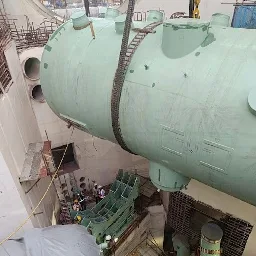
The installation of the steam generators has been completed at Unit 4 of the Kudankulam nuclear power station in Tamil Nadu state, southern India, Russian state nuclear corporation Rosatom said.
All four steam generators – each about 14 metres long with a diameter of four metres and weighing 340 tonnes – were installed using the ‘open top’ method, first used at Kudankulam-3.
This method allows large equipment to be loaded into the reactor building using a heavy-duty crane before the reactor dome is closed. Rosatom said it can significantly cut the time taken to carry out the installation.
Construction of the Generation III Kudankulam-4, a 917-MW VVER pressurised water reactor unit supplied by Russia, began in October 2017.
There are three other units of the same design under construction at the site. Construction of Kudankulam-3 began in 2017 and of Kudankulam-5 and -6 in 2021.
Kudankulam-1 and -2, also both VVER V-412 units, have been in commercial operation since December 2014 and March 2017.
-
Companies sign agreements to support Polish SMR deployment

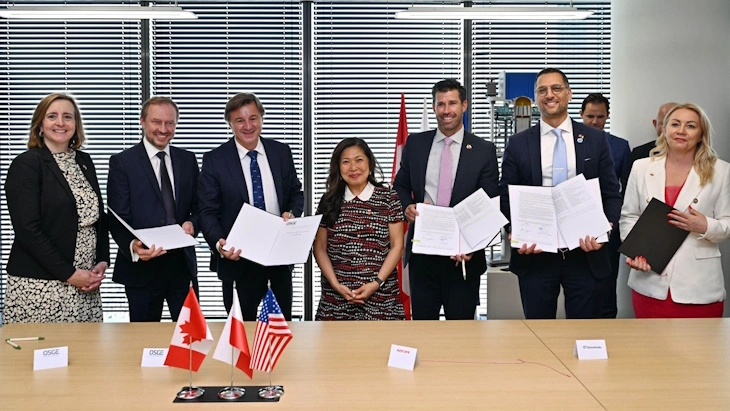
Source: https://www.world-nuclear-news.org/Articles/Companies-sign-agreements-to-support-Polish-SMR-de
Polish company ORLEN Synthos Green Energy (OSGE) has signed a teaming agreement and two bilateral agreements with North American companies to support the planned deployment of a fleet of BWRX-300 small modular reactors (SMRs) in Poland.
OSGE said the cooperation agreements with Aecon Group Inc and AtkinsRéalis company Candu Energy Inc, and the teaming agreement with Aecon, AtkinsRéalis and GE Hitachi Nuclear Energy, were signed at a ceremony in Warsaw, attended by Canada's Minister of Export Promotion, International Trade and Economic Development Mary Ng and Ambassador of Canada to the Republic of Poland Catherine Godin.
OSGE - a joint venture between chemical producers SGE and PKN Orlen - plans to deploy the first of a fleet of BWRX-300s before the end of this decade and received the go-ahead to begin environmental and siting research for a planned small modular reactor (SMR) project in Stawy Monowskie, in Małopolska, earlier this year.
"We are positioning ourselves as the partner of choice for utilities worldwide on deploying nuclear power technology," AtkinsRéalis President and CEO Ian Edwards said. "As Poland undertakes a visionary modernisation of its power grid, moving away from coal and toward nuclear power via both large and small reactors, we’re thrilled to offer our expertise to provide Poland with clean, reliable, and safe electricity for generations."
Construction and infrastructure company Aecon is the Canadian constructor of the first-of-a-kind BWRX-300 reactor which is to be built at Ontario Power Generation's Darlington New Nuclear Project, and is also delivering the ongoing nuclear refurbishment projects at Ontario Power Generation and Bruce Power's CANDU plants in partnership with AtkinsRéalis.
"We’re pleased to bring our full spectrum of construction solutions to support OSGE in collaboratively planning the deployment of the next generation of nuclear technology, contributing to the supply of clean, reliable and affordable electricity in Poland,” said Aecon Executive Vice President, Nuclear and Civil Thomas Clochard.
-
Simulator launched for development of Korea's i-SMR

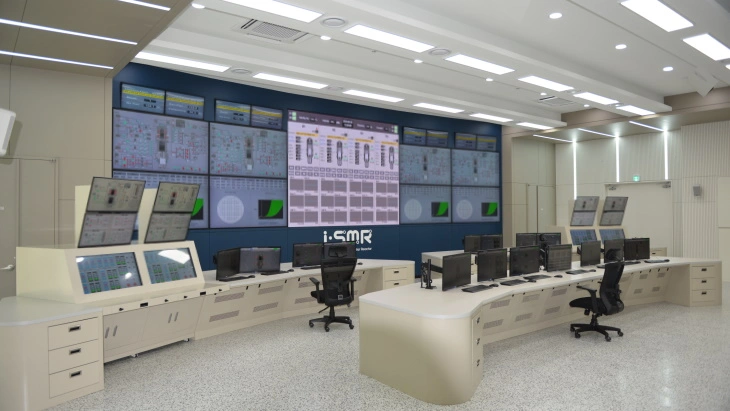
Source: https://www.world-nuclear-news.org/Articles/Simulator-launched-for-development-of-Korea-s-i-SM
Korea Hydro & Nuclear Power announced it has built an initial version of a simulator at the KHNP Central Research Institute to verify the operational suitability of the Innovative Small Modular Reactor (i-SMR).
The i-SMR is an integrated pressurised water reactor type nuclear power plant with an electrical output of 170 MWe. It is being developed according to a development roadmap, with the goal of completing the standard design by the end of 2025 and obtaining standard design approval in 2028.The i-SMR operation verification simulator will be used to verify design and operation suitability, and the verification results derived from the simulator operation process will be reflected in the standard design process, KHNP said.
It noted that the simulator developed to date is an early version that reflects the concept and basic design of the i-SMR.
The concept and basic design of the i-SMR was completed at the end of last year, and standard design will be carried out by December 2025. After 2025, update work will be carried out to reflect the standard design in the simulator, and development is accelerating with the goal of completing the simulator in the first half of 2027.
Once the simulator is completed, KHNP plans to use it to continue verifying the operational suitability of the i-SMR standard design, and plans to use the verification results as additional data for standard design approval.
"We will focus our existing experience in developing large-scale nuclear power plant simulators and the capabilities of researchers at KHNP to help obtain i-SMR standard design approval by creating a high-fidelity simulator," said Shin Ho-chul, head of the KHNP Central Research Institute.
KHNP has already signed a memorandum of understanding with Nusantara Power - a power generation subsidiary of Indonesian Electric Power Corporation - on mutual cooperation for the introduction and construction of the i-SMR in Indonesia. Through this MoU, the two companies will cooperate in various fields, including: joint basic research on the economic feasibility and technology for deployment of the i-SMR in Indonesia; development of local specialised technology through R&D cooperation; and collaboration through human/technology exchanges in the nuclear field through the formation of a working group.
KHNP has also signed an MoU on mutual cooperation with the Jordan Atomic Energy Commission for the deployment of the i-SMR in Jordan. The two organisations agreed to cooperate in comprehensive technology and information exchange on the i-SMR and to jointly conduct a feasibility study. Jordan is currently considering the introduction of SMRs after 2030 in preparation of expected increased electricity demand.
-
Grossi puts case at World Bank for financing new nuclear


Source: https://www.world-nuclear-news.org/Articles/Grossi-puts-case-at-World-Bank-for-financing-nucle
International Atomic Energy Agency Director General Rafael Mariano Grossi urges the World Bank and other multinational development banks to start financing new nuclear energy projects as part of efforts to achieve deep and rapid decarbonisation.
In his comments to members of the World Bank board, in Washington, USA, last week, Grossi said: "From Africa to Asia, countries seeking to add nuclear to their energy mix need technical and financial support. With its technical expertise, the IAEA accompanies them throughout their nuclear journeys, helping them to establish the infrastructure for a safe, secure and sustainable nuclear power programme. But financing remains a hurdle. While the private sector will need to increasingly contribute to financing, multilateral development banks such as the World Bank can advance sustainable development by assessing nuclear project bankability and contributing lending at affordable rates."
Although some multinational development banks have provided lending for decommissioning or upgrades to existing plants, they do not contribute to the financing of new-build projects. The pledge to aim for a tripling of nuclear energy capacity, backed by more than 20 countries at COP28 in December, included inviting "shareholders of the World Bank, international financial institutions, and regional development banks to encourage the inclusion of nuclear energy in their organisations’ energy lending policies as needed, and to actively support nuclear power when they have such a mandate, and encourage regional bodies that have the mandate to do so to consider providing financial support to nuclear energy".
The International Energy Agency says nuclear energy capacity should more than double by 2050 to meet climate targets, and the IAEA has estimated that doing so would mean more than doubling annual investment in nuclear power to USD100 billion.
Discussing the issue with the members of the World Bank board, Grossi said that the IAEA "stands ready" to provide any technical assistance required by multinational lenders in relation to nuclear infrastructure development, nuclear safety, security and safeguards.
The IAEA says there are about 30 countries considering or embarking on nuclear power, with about two-thirds of them in the developing world and financing remains a major hurdle for many.
-
Advanced Reactors / Copenhagen Atomics Signs Collaboration Agreement With Switzerland’s PSI
www.nucnet.org Advanced Reactors / Copenhagen Atomics Signs Collaboration Agreement With Switzerland’s PSIDanish company plans experiments to validate TMSR nuclear technology
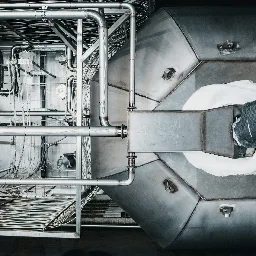
Danish thorium molten salt reactor (TMSR) developer Copenhagen Atomics has signed an experimental collaboration agreement with Switzerland’s Paul Scherrer Institute (PSI), to validate the TMSR technology.
The partnership between Copenhagen Atomics and PSI aims to conduct a thorium molten salt critical experiment in 2026, a statement said.
Copenhagen Atomics said the experiment will provide valuable experience for the design, construction, licensing, operation and decommissioning of the new MSR technology and collect data for commercial deployment.
The collaboration agreement runs initially for four years and will position Europe at the forefront of advanced reactors, Copenhagen Atomics said.
It said TMSR technology has huge potential to become one of the world’s most abundant energy sources. To date, the bulk of TMSR experiments have taken place in China, so this represents “a major step forward for the tech in Europe”, Copenhagen Atomics said.
The company said the use of thorium over uranium has several advantages. Thorium, a naturally occurring radioactive metal that is found in soil, rock and water, is much more abundant than uranium and there is enough thorium in the Earth’s crust to “cover the entire lifetime of the human race”.
According to Copenhagen Atomics, thorium offers a lower price per kWh of energy generated and produces less long-lived nuclear waste than uranium.
In 2023 Copenhagen Atomics said it had raised €20m ($21.4m) to accelerate the development of its TMSR technology.
Co-founder Thomas Jam Pedersen said the funding would support plans to have the first commercial reactors online in 2028.
-
PPL expands Kentucky nuclear feasibility study

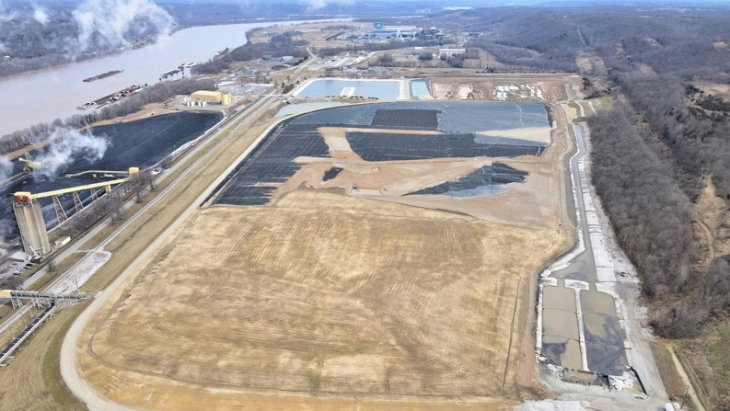
Source: https://www.world-nuclear-news.org/Articles/PPL-expands-Kentucky-nuclear-feasibility-study
US utility PPL Corporation announced that two of its subsidiaries will build on an earlier assessment of nuclear feasibility at the Ghent coal-fired power plant site in Kentucky by exploring additional locations and partnerships that could support nuclear energy in the state.
Ghent is a four-unit, coal-fired power plant with a combined net generating capacity of 1919 MWe and is planned for phased retirement, with units 1 and 2 retiring first and units 3 and 4 retiring afterwards. The plant is located within five miles of several industrial companies that consume large amounts of electricity and may be potential process heat customers. PPL owns about 2300 acres of land around and including the Ghent plant site.
The earlier study, funded by a grant under the Department of Energy's (DOE's) GAIN - Gateway for Accelerated Innovation in Nuclear - initiative and published in March, found that the Ghent site is suitable for a small modular reactor (SMR) plant. However, the site was found to have potential size constraints for a larger conventional reactor.
GAIN - Gateway for Accelerated Innovation in Nuclear - is an initiative launched in 2016 by the DOE Office of Nuclear Energy which helps businesses overcome critical technological and commercialisation challenges of nuclear energy technologies through a voucher system, giving stakeholders access to the DOE's R&D facilities and infrastructure to support the cost-effective development of innovative nuclear energy technologies. All awardees are responsible for a minimum 20% cost-share, which could be an in-kind contribution.
As with earlier feasibility assessments at PPL subsidiaries Louisville Gas & Electric Company's and Kentucky Utilities Company's Ghent site, PPL's research and development team plans to partner with GAIN and nuclear design engineering company X-energy in the next phase of assessments.
X-energy says its Xe-100 is a Generation IV advanced reactor design based on decades of high temperature gas-cooled reactor operation, research, and development. Designed to operate as a standard 320 MWe four-pack power plant or scaled in units of 80 MWe, it is engineered to deliver reliable and load-following grid-scale power to electricity systems and to pair seamlessly with renewables. At 200 MWt of 565°C steam, the Xe-100 is also suitable for other power applications including mining and heavy industry.
Phase two of the study will explore alternative locations and industrial partnerships that could enable energy-intensive customers - including manufacturers and data centres - to achieve their zero-carbon objectives while maintaining reliability and affordability, PPL said.
"We understand that achieving our goal of net-zero carbon emissions will be challenging, and we continue to pursue an all-of-the-above technology strategy to replace aging generation with a cleaner, more diverse energy mix capable of safely, reliably and affordably meeting our customers' future energy needs and supporting continued economic growth," said PPL President and CEO Vincent Sorgi.
"Nuclear energy is a carbon-free solution that has the potential to meet our customers' needs and support manufacturing and data centre growth, particularly if technology such as nuclear SMRs become more cost-competitive," he added. "These in-depth studies are important to determining whether nuclear energy at our locations may be a viable solution moving forward."
-
IAEA concern at damage to Zaporizhzhia radiation monitoring station

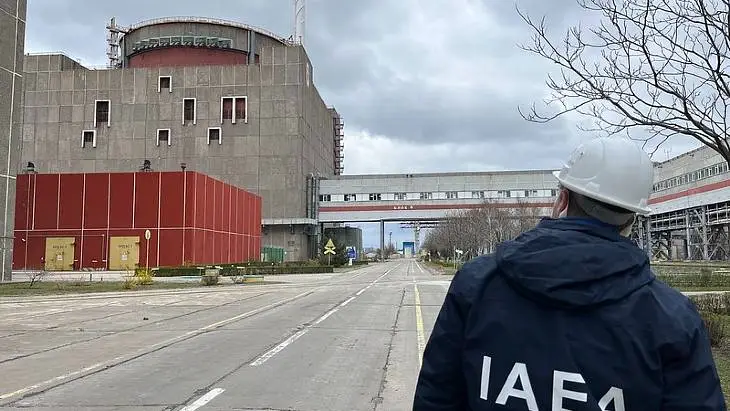
Source: https://www.world-nuclear-news.org/Articles/IAEA-concern-at-damage-to-Zaporizhzhia-radiation-m
An external radiation monitoring station was reported to have been destroyed by shelling and fire, with four of the 14 pre-conflict stations currently unavailable, International Atomic Energy Agency Director General Rafael Mariano Grossi said.
The Zaporizhzhia nuclear power plant (ZNPP) has six units and is Europe's largest. It has been under Russian military control since early March 2022 and is located on the frontline of Russian and Ukrainian forces. In an effort to try to reduce the risks to nuclear safety of the situation there have been IAEA experts stationed at the site since September 2022.
The current rotation of agency experts were told by the operators of the plant that it lost connection to the monitoring station, which is about 16 kilometres away, on Monday afternoon. The agency says that during the conflict several radiation monitoring stations within 30 kilometres of the plant have been out of service for varying periods of time.
Last week there was a 16-hour loss of power in the associated city of Energodar, where many of the nuclear power plant staff and their families live, which the IAEA said "caused a temporary halt in the operation of some of the environmental radiological monitoring stations after they ran out of back-up battery".
Grossi said: "The loss of one radiation monitoring station does not have a direct impact on safety at the ZNPP, but it forms part of a continuous erosion of a range of safety measures during the war that remains a deep source of concern.
"The functioning of off-site radiation monitoring equipment is an essential part of nuclear safety around the world. These systems are important for continuously monitoring radiation levels and, in the case of an emergency, for quickly assessing the ongoing and potential radiological impact and what protective actions may need to be taken."
Ukraine is among 51 countries which participate in the IAEA's International Radiation Monitoring System which collects monitoring data from more than 6000 monitoring stations operating across the world.
In the IAEA's latest update on the safety and security situation for Ukraine's nuclear power plants, it said that staff at Zaporizhzhia continued to hear regular explosions some distance from the plant. Among their activities this week they had witnessed the testing of an emergency diesel generator, to check it started up within 11 seconds of the loss of off-site power, and had also visited the site's temporary on-site emergency centre.
There are also IAEA teams at Ukraine's other nuclear power plants, with those at the South Ukraine nuclear power plant reporting there had been military action in their region, although they were told that neither their hotel nor the plant itself had been targeted. The IAEA also reported that it had arranged two more deliveries of equipment to Ukraine in the past week - taking the total since February 2022 to 51 - to support the country in maintaining nuclear safety and security.
-
Uzbekistan SMR plant construction preparations under way

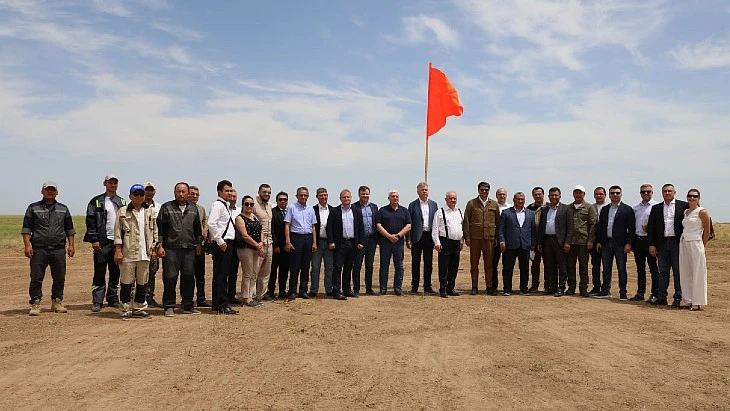
Source: https://www.world-nuclear-news.org/Articles/Uzbekistan-SMR-plant-construction-site-preparation
Infrastructure work for a six-unit small modular reactor nuclear power plant in Uzbekistan is expected to begin in the autumn, after the signing of a protocol on the entry into force of the construction contract signed last month.
The signing ceremony was held during a visit by representatives of the UzAtom Atomic Energy Agency and Rosatom to the site of the proposed plant and an inspection of where land surveying and the setting up of a construction camp and infrastructure facilities are to begin from September.
Andrey Petrov, deputy director general of Rosatom, said: "Our large-scale project for the construction ... is picking up momentum to provide the region with clean energy. We know our Uzbek partners as efficient, talented managers, and now we are starting joint activities at the construction site. I am sure that we will fulfill together all contractual obligations on time and in proper quality."
The creation of a residential settlement for construction and project teams were among the priority tasks discussed and agreed during the visit to the site in the Jizzarkh region of Uzbekistan.
The contract signed on 27 May, during a visit to the country by Russian President Vladimir Putin, is for the construction of a 330 MW capacity nuclear power plant. The project is based on six units of the RITM-200N water-cooled reactor, which is adapted from nuclear powered icebreakers' technology, with thermal power of 190 MW or 55 MWe and with an intended service life of 60 years. The first unit is scheduled to go critical in late 2029 with units commissioned one by one.
It is the first export order for Russia's SMR. The first land-based version is currently being built in Yakut in Russia, with the launch of the first unit expected to take place in 2027. Rosatom says that its combination of active and passive safety systems mean the SMR plants will achieve the highest possible safety standards.
In 2017, Uzbekistan signed an agreement with Russia to construct two VVER-1200 pressurised water reactors and, following the signing of the SMR plant agreement last month, Rosatom's Director General Alexei Likhachev said, in an interview with the Rossiya-1 TV channel, that there were still proposals for building a large nuclear power plant - with a capacity of around 2.5 GW - in Uzbekistan.
-
Belgium / SCK CEN Begins First Phase Of Myrrha Research Reactor Construction
www.nucnet.org Belgium / SCK CEN Begins First Phase Of Myrrha Research Reactor ConstructionInitial work focused on particle accelerator known as Minerva

Construction has begun on the first phase of a new nuclear research reactor in Belgium that could be fully operation by 2038 for nuclear research and the production of crucial medical radioisotope.
The Myrrha reactor at the Belgian Nuclear Research Centre (SCK CEN) in Mol will be a multifunctional research facility and the first research reactor driven by a 300-metre-long particle accelerator known as Minerva.
The system consists of a particle accelerator that delivers a beam to a spallation target, which in turn couples to a subcritical lead-bismuth cooled fast reactor.
On 25 June a groundbreaking ceremony was held to mark the start of Minerva’s construction, the first phase of the Myrrha project. The ceremony was attended by Belgium’s energy minister Tinne Van der Straeten.
Phase one of the project will be the construction of Minerva, which consists of the particle accelerator and two target facilities. In phase two, the particle accelerator will be expanded to increase its applications. In phase 3, reactor itself will be built.
A particle accelerator uses electromagnetic fields to propel charged particles to very high speeds and energies. They can be used for a number of applications including fundamental research in particle physics and radioisotope production.
SCK CEN said that when complete Myrrha will provide radioisotopes for improved cancer treatments, fundamental physics research, fusion materials research, accelerator technology and the processing of radioactive nuclear waste.
In December 2018 Belgium approved €558m in funding for Myrrha. In 2010, it gave the go-ahead for construction.
Belgium is to contribute 40% of the €1.6bn investment. The Myrrha project is a partnership of Belgium, the European Union, the European Investment Bank and other partners, with 70% of the funding from EU countries.
-
Slovenia / State To Publish Krško Seismic Research Ahead Of Planned Referendum On New Nuclear
www.nucnet.org Slovenia / State To Publish Krško Seismic Research Ahead Of Planned Referendum On New NuclearGov’t targeting operation of second reactor in 2040s
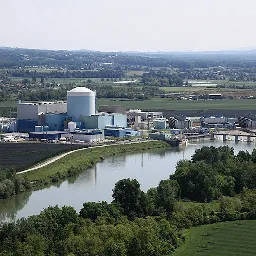
Slovenia’s state-owned power company GEN Energija is to make public research showing that the location of the existing Krško nuclear power station and a planned new reactor is safe from the point of view of seismic activity.
The company also said it will also publish further studies related to various aspects of the new-build project before a final decision is taken and a planned referendum is held.
GEN Energija said that, at the request of the Ministry of the Environment, Space & Energy, a series of documents related to various studies and reviews will be published on the new-build project website by October to enable people to make an informed decision in the referendum.
Slovenia wants to build a new nuclear plant at the Krško site, in the east of the country, and is planning a referendum on the issue, although no date has been set. The new build project is known as JEK2.
In an update on its new build plans GEN Energija said that to assess the seismic risk in the area of the existing Krško plant and the planned location of JEK2, two types of analysis had been used based on internationally established methodology – probabilistic seismic hazard analysis (PSHA) and probabilistic fault displacement hazard analysis (PFDHA).
A PSHA was ordered by Slovenian nuclear utility Nuklearna Elektrarna Krško (NEK) in 1994 and 2004.
From 2008 to 2011, geotechnical, geological and seismological research was carried out. That research led one of the four partners, France’s Institut de Radioprotection et de Sûreté Nucléaire to express concerns about a possible active fault and suggest performing a PFDHA.
Other project partners including the Geological Survey of Slovenia did not express similar concerns. However, GEN Energija commissioned the PFDHA and an international independent review, which concluded that the probability of fault movements was “insignificant”.
‘Negligible’ Risk To Existing Or New Reactors
This was followed by another PFDHA in 2013, which concluded there were extremely small, negligible risks of exceeding surface displacements for engineering needs.
The authors of the study and the independent international reviewers agreed that the danger was negligible and did not pose a risk to the existing or to the new nuclear power station.
A large-scale PSHA project is underway, which began in 2015. The third and final phase of the project is undergoing an independent international review, which will be completed later this year.
The existing single 688-MW PWR at Krško, which was built in cooperation with US company Westinghouse, began commercial operation in 1983. The facility is co-owned in equal shares by the governments of Slovenia and neighbouring Croatia.
In January 2023, Slovenian authorities approved a 20-year operating lifetime extension to Krško, meaning the reactor unit could operate until 2043, a total of 60 years.
Slovenia has been considering the construction of a second plant at the site and earlier reports said a final decision on the project would be made in 2027 or 2028, with commercial operation in the mid-2040s.
-
US / DOE Launches Bid To Buy Up To $2.7 Billion Of Uranium From Domestic Sources
www.nucnet.org US / DOE Launches Bid To Buy Up To $2.7 Billion Of Uranium From Domestic SourcesAim is to secure supply for nuclear reactors and move away from Russia
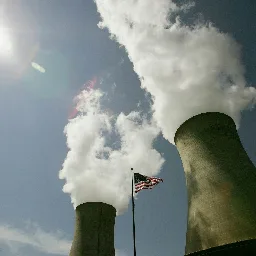
The US has issued a request for proposals to buy up to $2.7bn (€2.5bn) of enriched uranium from domestic sources in an effort to boost supplies of the nuclear reactor fuel and move the country away from buying it from Russia, the Department of Energy (DOE) said on Thursday.
The DOE said the move will help spur the build-out of uranium enrichment capacity in the US, promote diversity in the market, and provide a reliable supply of commercial nuclear fuel to support the energy security and resilience of the American people and domestic industries, free from Russian influence.
The $2.7bn in funding was part of legislation signed by president Joe Biden in May that imposed a ban on imports of enriched uranium from Russia, as part of sanctions on the country for its full-scale invasion of Ukraine.
Last year Russia provided almost a quarter of the enriched uranium used to fuel the US’s fleet of 94 nuclear plants, making it the number one foreign supplier to the US, according to the DOE.
According to the US Energy Information Administration, Russia has been supplying about 24% of enriched uranium with 12% from Germany and 11% from the UK. The US itself supplies 27%. Those sales provide an estimated $1bn a year to Russia.
The DOE said it plans to award two or more contracts, which will last for up to 10 years. The sources can include new enrichment facilities or projects that expand the capacity of existing enrichment facilities.
“DOE is helping jumpstart uranium enrichment capacity here in the United States, which is critical to strengthening our national security and growing our domestic nuclear industry,” said energy secretary Jennifer Granholm.
-

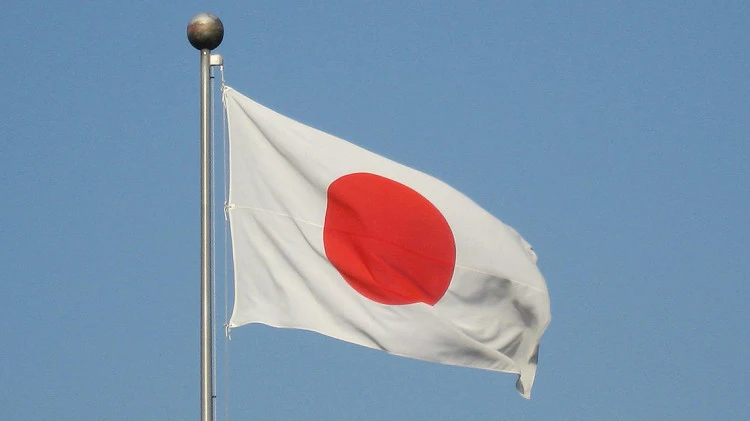
Source: https://www.iaea.org/newscenter/pressreleases/tritium-level-in-seventh-batch-of-alps-treated-water-far-below-japans-operational-limit-iaea-confirms
International Atomic Energy Agency (IAEA) experts have confirmed that the tritium concentration in the seventh batch of diluted ALPS treated water, which the Tokyo Electric Power Company (TEPCO) began discharging today, is far below Japan’s operational limit.
The treated water was sampled by IAEA experts stationed at the Agency’s office at the site of the Fukushima Daiichi Nuclear Power Station (FDNPS). After conducting an independent on-site analysis, the IAEA confirmed that the tritium concentration in the diluted water is far below the operational limit of 1500 becquerels per litre and is in line with international safety standards.
Japan plans to continue discharging the ALPS-treated water from the FDNPS in batches. The IAEA has earlier confirmed that the tritium concentrations in the previous six batches, totalling approximately 46,500 cubic meters of water, were far below operational limits.
Japan’s plan is to conduct a series of controlled discharges of ALPS treated water into the sea over a period of decades. The sixth batch was discharged from May 17 to June 4.
In a comprehensive report issued on 4 July 2023, the IAEA’s safety review found that Japan’s plan for handling the treated water was consistent with international safety standards and that the release as planned would have a negligible radiological impact to people and the environment.
All reports on sampling, independent analysis, data evaluation, as well as timeline, will be available on the IAEA website.
-
r/NuclearPower is taken over by a hostile mod
Kyle Hill, known pro-nuclear science communicator, was banned from the Reddit community r/NuclearPower for his pro-nuclear stance.
Turns out the community has been taken over by anti-nuclear mod(s).
Posting about this I’ve been banned too 😂
If you remain on Reddit, r/Nuclear is still a valid community. Otherwise we exist of course!
Kyle’s post on Threads on this: https://www.threads.net/@sci_phile/post/C8xqujdy2ge/
-
French molten salt research lab aims to become leader in field


Source: https://www.world-nuclear-news.org/Articles/French-molten-salts-research-lab-aims-to-become-le
Naarea, the developer of a molten salt fast neutron microreactor, is partnering with the French National Centre for Scientific Research (CNRS) and Université Paris-Saclay to create a laboratory dedicated to molten salt chemistry which aims to be the European leader in research and development for both nuclear molten salt reactors and non-nuclear applications.
The new Innovation Molten Salt Lab will bring together the 20-years of expertise in molten salts chemistry from the Laboratoire de Physique des 2 Infinis Irène Joliot-Curie (ICJLab) with Naarea's "technological knowledge in the fields of materials, neutronics, safety analysis and materials and fuel data".
A statement announcing the project said the new lab's roadmap "will aim to foster collaborative work and capitalise on the concepts and innovations developed at Naarea to the benefit of the European molten salt reactor sector ... the goal ... is to become the European leader in the field of molten salts research and development, for both molten salt nuclear reactors and other non-nuclear applications such as metallurgy and concentrated solar power".
In quotes
Naarea CEO Jean-Luc Alexandre said the new lab "allows us to pool our skills and demonstrates our ability to step up our efforts to develop our XAMR project ... [and] marks a significant milestone for Naarea, which is positioned to make a vital contribution to establishing and achieving recognition for true French leadership and expertise in the field of molten salt research at the European level. This valuable expertise will not only have a positive impact on Naarea, but also on a variety of industrial sectors, whether related to nuclear energy or not".
Deputy CEO for Innovation at the CNRS, Jean-Luc Moullet, called it "an ambitious joint laboratory that symbolises the contribution of French research to the revival of the nuclear sector. The CNRS encourages the development of joint laboratories, which offer a flexible and long-term framework conducive to the development of fruitful public-private partnerships".
President of Université Paris-Saclay, Camille Galap, said: "Université Paris-Saclay is a research-intensive university committed to contributing to finding solutions to scientific and technological challenges. We are therefore delighted to join this partnership with Naarea and the CNRS to create the joint laboratory IMS Lab, whose research work will help respond to the critical challenges of decarbonising energy, in particular for industry."
The background
Naarea - the name is taken from Nuclear Abundant Affordable Resourceful Energy for All - was founded in 2020 and was one of the winners of the France 2030 investment plan for innovative nuclear reactors. It is developing the XAMR, an advanced modular reactor, a molten salt fast neutron microreactor capable of producing 40 MWe of electricity/80 MWt of heat that will burn plutonium and by reusing long-lived nuclear waste help close the fuel cycle.
The company says the XAMR will be about the size of a bus and it intends to target applications in areas such as transportation, agriculture and smart buildings. Naarea says that, because of the compact size of its reactor and because there is no need for it to be grid-connected, the XAMR can "be deployed as close as possible to regions, to match energy demand as closely as possible and allow the control of security of supply, at the service of industries and communities". The aim is to be on the market by 2030.
MSRs use molten fluoride salts as primary coolant, at low pressure. They may operate with epithermal or fast neutron spectrums, and with a variety of fuels. Much of the interest today in reviving the MSR concept relates to using thorium (to breed fissile uranium-233), where an initial source of fissile material such as plutonium-239 needs to be provided. There are a number of different MSR design concepts, and a number of interesting challenges in the commercialisation of many, especially with thorium.
-
Fuel assemblies with 3D-printed bottom nozzles tested

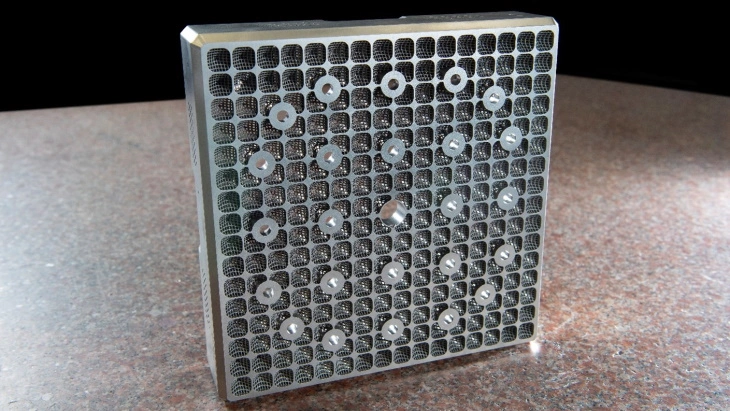
Source: https://www.world-nuclear-news.org/Articles/Fuel-assemblies-with-3D-printed-bottom-nozzles-tes
Four lead test assemblies supplied by Westinghouse featuring 3D-printed bottom nozzles have been used at Southern Nuclear's Farley nuclear power plant in Alabama. Westinghouse says the components improve debris capture and fuel endurance within its fuel assemblies.
According to the company, debris-wearing action on the fuel rod cladding - known as debris fretting - is the primary source of leaks in pressurised water reactor (PWR) fuel assemblies.
Additive manufacturing technology, it says, offers significant improvements in debris filtering thanks to enhanced design freedom which reduces the diameter of debris that can enter into the reactor. In testing, the additively manufactured components demonstrated a 30% improvement in debris resistance, from 65% to 96%.
"Our additive manufacturing technology is allowing us to achieve breakthrough performance with an immediate positive impact for our customers," said Westinghouse President of Nuclear Fuel Tarik Choho. "This significant technology innovation for PWR reactors mitigates the risk of leakage in the fuel rods due to the accumulation of debris, strengthening the safety and efficiency of our customers' operations."
Southern Nuclear President Pete Sena added: "Over the past decade, Southern Nuclear has led the industry in the development and implementation of new technologies that improve fuel resiliency. The existing nuclear power fleet is the backbone of our country's clean energy supply, and we are innovating nuclear fuel today to be more robust in order to deliver safer, more affordable and more reliable carbon-free clean nuclear power for decades to come."
Additive manufacturing (AM) - or 3D printing - simplifies the manufacturing process by building a three-dimensional object from a computer-aided design model, usually by successively adding material layer by layer.
In 2015, Westinghouse conducted the first-ever material irradiation study of AM nuclear components. In 2020, the company installed the first-ever safety-related AM component, a thimble plugging device, into an operating commercial reactor, unit 1 of Exelon's Byron plant in Illinois.
Nuclear fuel debris filters manufactured by Westinghouse using 3D printing technology have been installed at unit 2 of the Olkiluoto plant in Finland and unit 3 of the Oskarshamn plant in Sweden. Westinghouse said the StrongHold AM filters are fully manufactured through 3D printing techniques and offer enhanced capture features to prevent debris from entering the fuel assembly and potentially damaging the cladding, which could cause unplanned and expensive outages.
In 2024, Westinghouse produced the 1000th additive manufacturing component for VVER-440 fuel.
-
Containment tests completed at first Zhangzhou unit

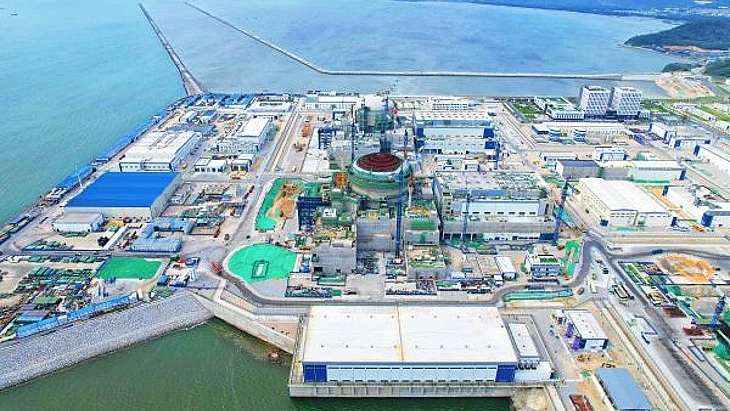
Source: https://www.world-nuclear-news.org/Articles/Containment-tests-completed-at-first-Zhangzhou-uni
Tests to check the integrity of the containment structure have been completed at unit 1 of the Zhangzhou nuclear power plant in China's Fujian province. The unit is the first of three Hualong One (HPR1000) reactors under construction at the site.
The two-part tests confirm that the containment vessel meets design and construction quality requirements. The first part - the structural integrity test - involved the vessel being pressurised and monitored to confirm that its design and construction meet all applicable industry codes and standards at 110% of design pressure.
The vessel was then pressurised to design pressure (0.420 MPa) and the integrated leak rate test was performed to demonstrate its ability to prevent the release of radioactive materials in the event of an emergency.
During the containment pressure test, the containment leakage is checked through the acoustic leak detection test, and the changes in the containment structure performance are monitored through internal visual inspection and external visual inspection tests.
The tests were successfully completed on 20 June, China National Nuclear Corporation (CNNC) subsidiary China Nuclear Industry 23 Construction Company Limited (CNI23) announced.
China's Ministry of Ecology and Environment issued construction licences for Zhangzhou units 1 and 2 on 9 October 2019 to CNNC-Guodian Zhangzhou Energy Company, the owner of the Zhangzhou nuclear power project, which was created by CNNC (51%) and China Guodian Corporation (49%) in 2011. Construction of unit 1 began one week after the issuance of the construction licence, with that of unit 2 starting in September 2020.
"According to the plan, unit 1 will generate electricity within the year, which will drive the economic and social development of southern Fujian and serve as a new development engine for the region to achieve carbon peak and carbon neutrality goals," CNNC said last month. It noted that preparations are currently under way for cold functional tests at unit 2.
In September 2022, China's State Council approved the construction of two further Hualong One units as Phase II of the Zhangzhou plant. First concrete for the nuclear island of unit 3 was poured on 22 February this year. CNNC said first concrete for unit 4 is expected "within the year".
-
Kazakhstan's nuclear energy referendum to be held this year

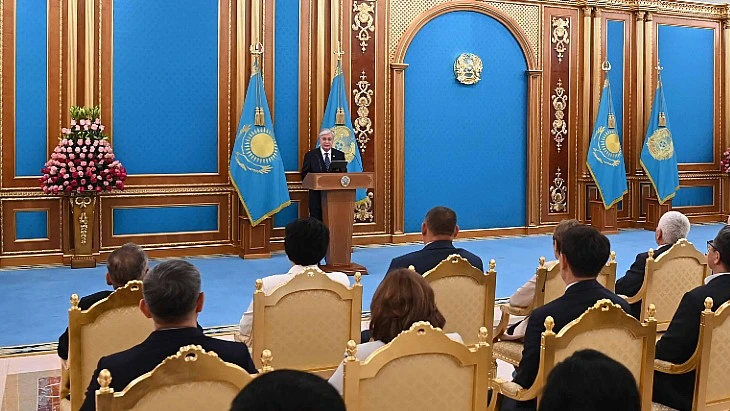
Source: https://www.world-nuclear-news.org/Articles/Kazakhstan-s-nuclear-energy-referendum-to-be-held
President Kassym-Jomart Tokayev has said that a referendum on plans for a nuclear power plant in Kazakhstan will be held this autumn.
In a speech to media representatives in the country, the president said that "a stable source of energy is necessary for the development of the economy". He said there was "a comprehensive discussion" taking place about the proposed nuclear power plant with "different opinions" and he said the country's mass media "should also actively participate in this process".
He added: "There is a great opportunity to develop nuclear energy in the country. It should be used correctly, effectively. The people will make the final decision on this issue. The referendum will be held this autumn and the government will determine the exact date."
The potential reintroduction of nuclear power is aimed at reducing the country's reliance on fossil fuels, diversifying its energy mix and reducing CO2 emissions. Kazakhstan Nuclear Power Plant (KNPP), which has been designated as the owner/operator of the future plant, began preparing a feasibility study in 2018 to justify the need for nuclear power, the choice of the location for plant construction and to review the plant's projected power output.
Although a positive result in the referendum will be needed for the project to go ahead, some details of the proposed plan have already been emerging, with the World Nuclear Spotlight event in April in the country hearing that a site at Ulken, on the shores of Lake Balkhash, had been identified as the most suitable location, with Kurchatov as a backup region. The proposed first nuclear power plant would be a large reactor but there are also options for using small modular reactors to replace retiring coal plants in the years to come. The government's target is for nuclear to produce a 5% share of the national generation mix by 2035.
The background
Kazakhstan has 12% of the world's uranium resources and in 2022 it produced 43% of the world's uranium. It has three operating research reactors and a Russian-designed BN-350 sodium-cooled fast reactor operated near Aktau for 26 years, until 1999.
In November 2023, an International Atomic Energy Agency team conducted a five-day Site and External Events Design (SEED) mission to review the country's site selection process. In January 2023, the Ministry of Energy said that four foreign potential suppliers of nuclear technology were being considered - EDF of France, China National Nuclear Corporation, Korea Hydro & Nuclear Power and Rosatom of Russia.
- www.nucnet.org Japan / Regulator Gives Go-Ahead For Ohi Nuclear Reactors To Operate For Up To 40 Years
NRA has approved long-term operation plan under new law
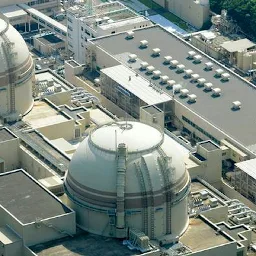
Japan’s Nuclear Regulation Authority (NRA) has approved extensions to the operational lifetimes for Units 3 and 4 at Kansai Electric Power’s Ohi nuclear station based on a law that was enacted in May last year.
It is the first time the nuclear regulator has approved a long-term facility management plan based on the green transformation law, which is scheduled to take full effect in June 2025.
The two reactors at the station in the town of Ohi, Fukui Prefecture, western Japan, both began operation over 30 years ago. Following the NRA approval, they are now allowed to operate for up to 40 years.
Under the law, nuclear operators must formulate a long-term reactor management plan and gain approval from the regulator at least once every 10 years if they are to continue to operate.
The new policy effectively extends the period reactors can remain in operation beyond 60 years by excluding the time they spend offline for inspections from the total service life.
Ohi-3 can now operate until 17 December 2031 an Ohi-4 until 1 February 2033.
Ohi-3 and -4 are both 1,127-MW pressurised water reactor units. Ohi-3 began commercial operation in 1991 and Ohi-4 in 1993.
Before Fukushima-Daiichi, Japan’s fleet of 54 nuclear plants generated about 30% of the country’s electricity, but were all shut down for safety checks following the accident.
Among the 33 operable nuclear reactors in Japan, 12 have resumed operations after meeting post-Fukushima safety standards. The restarted plants are: Sendai-1 and -2, Genkai-3 and -4, Ikata-3, Mihama-3, Ohi-3 and -4 and Takahama-1, -2, -3 and -4.
According to the International Atomic Energy Agency nuclear generated about 6.1% of the country’s electricity in 2022. The Tokyo-based Japan Atomic Industry Forum said recently that the fleet generated 81 TWh of electric power in 2023, about 50% higher than 2022.
- www.nucnet.org Finland / Fortum Announces Completion Of First Nuclear Decommissioning Project
FiR1 research reactor operated for 50 years near capital of Helsinki
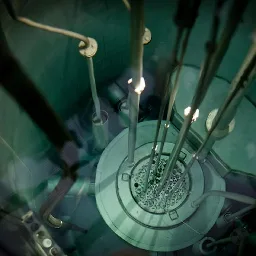
Finland has successfully completed its first nuclear decommissioning project with the dismantling of the FiR1 research reactor, which operated for over 50 years at the VTT Technical Research Centre premises in Otaniemi, Espoo, near the capital Helsinki.
The decommissioning project was carried out by utility Fortum, which owns and operates the Loviisa nuclear station in Finland, in collaboration with VTT, the reactor’s owner.
The dismantling process, which began in June 2023 and ended in April 2024, marked a significant milestone in Finland’s nuclear industry, said Fortum. VTT received regulatory approval for decommissioning in 2021.
The company handled the full scope of the decommissioning work including planning, preparatory measures, reactor dismantling, waste management and the final disposal of radioactive waste.
Fortum said the project provided significant experience for both Fortum and VTT, particularly in preparing the extensive documentation required for the decommissioning licence. It said the experience will be valuable for future projects.
The decommissioning generated approximately 60 cubic meters of demolition waste, primarily concrete, which will be disposed of in Fortum’s Loviisa nuclear power station’s repository for low- and intermediate-level waste.
Fortum said that given the reactor’s use for research and educational purposes, the amount of decommissioning waste and its associated radioactivity were relatively small.
FiR1 was Finland’s first nuclear reactor. It was of the Triga design with a thermal output of 250 kW.
The reactor began operation in 1962 and was first used by the Helsinki University of Technology. It was permanently shut down in 2015.
According to VTT, after 1999, the FiR1 reactor was used in collaboration with the Hospital District of Helsinki for cancer therapeutic purposes until the treatment provider went out of business in 2012.
-
OPG expands green financing to include new nuclear

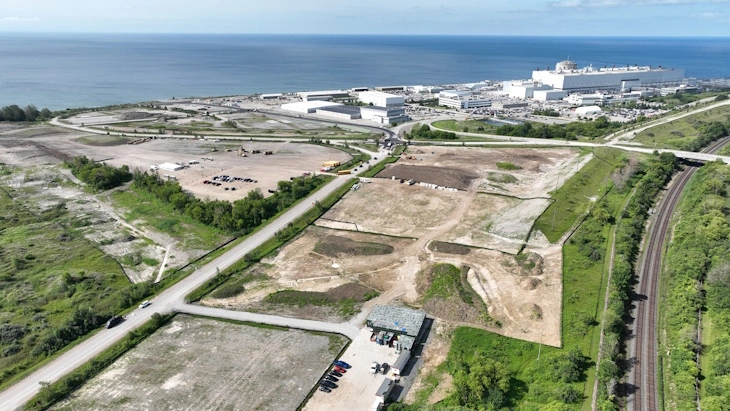
Source: https://www.world-nuclear-news.org/Articles/OPG-expands-green-financing-to-include-new-nuclear
Ontario Power Generation's new Sustainable Finance Framework replaces its 2021 Green Bond Framework and will permit funding of a broader range of clean energy technologies. It now allows net proceeds from the bond to be used for new nuclear projects as well as to provide funding for existing nuclear facilities.
Green bonds are financial instruments that finance green projects and provide investors with regular or fixed income payments. The key difference between green bonds and regular bonds is that the money raised from investors is used exclusively to finance projects that have a positive environmental impact.
Ontario Power Generation (OPG) was the first Canadian utility to release green bonds in Canada and, together with its subsidies, has issued more than CAD3 billion (USD2.2 billion) of green bonds to date. In 2022, it updated its Green Bond Framework to allow net proceeds from green bonds to be used to finance maintenance and/or refurbishment of existing nuclear facilities, and issued a first-of-its-kind nuclear green bond offering for CAD300 million. The net proceeds from the issuance were allocated to the Darlington nuclear power plant refurbishment project.
OPG says the new Sustainable Finance Framework will permit funding of a broader range of clean energy technologies as well as initiatives to create opportunities for Indigenous communities and businesses. New nuclear projects, such as small modular reactors and large new nuclear, may now be financed from the net proceeds from OPG's sustainable bond issuance, as well as the maintenance or refurbishment of existing facilities.
The sustainable bonds may also be used to finance renewable energy projects like hydro refurbishment, solar, wind and hydrogen production; energy efficiency and management solutions such as energy storage and clean fuel storage; clean transportation initiatives such as zero-emissions vehicles; and developing climate adaptation and resilience capabilities for flood protection and extreme weather.
"As Canada's largest corporate green bond issuer, expanding our eligible use of proceeds from these bonds recognises growing demand for clean electricity and OPG's commitment to advancing economic Reconciliation with Indigenous Nations and communities," said OPG Chief Financial Officer and Corporate Services Officer Aida Cipolla. "Partnerships will be key to achieving economy-wide decarbonisation and lasting environmental benefits."
OPG recently completing early site works for the construction of the first of four BWRX-300 small modular reactors at its Darlington New Nuclear project, as well as being more than half-way through a CAD12.8 billion project to refurbish the four Candu units at its Darlington plant, which is scheduled to be completed by the end of 2026. It is also initiating a project to refurbish units 5-8 at its Pickering plant.
-
Ohi units cleared for another 10 years' operation

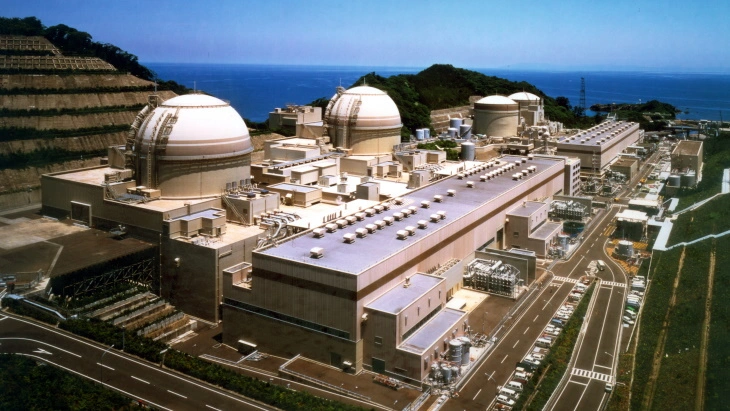
Source: https://www.world-nuclear-news.org/Articles/Ohi-units-cleared-for-another-10-years-operation
Japan's nuclear regulator has approved Kansai Electric Power Company's long-term reactor management plan for units 3 and 4 of its Ohi nuclear power plant in Fukui prefecture, allowing the units to operate beyond 30 years. They become the first reactors to be permitted to operate up to 40 years under new legislation.
Under regulations which came into force in July 2013, Japanese reactors had a nominal operating period of 40 years. One extension to this - limited to a maximum of 20 years - could be granted, requiring amongst other things, a special inspection to verify the integrity of reactor pressure vessels and containment vessels after 35 years of operation.
However, in December 2022, the NRA approved a draft of a new rule that would allow reactors to be operated for more than the current limit of 60 years. Under the amendment, the operators of reactors in use for 30 years or longer must formulate a long-term reactor management plan and gain approval from the regulator at least once every 10 years if they are to continue to operate. The new policy effectively extends the period reactors can remain in operation beyond 60 years by excluding the time they spent offline for inspections from the total service life.
The legislation was approved by Japan's Cabinet in February last year and enacted in May 2023. It comes into full effect in June next year.
The Ohi 3 and 4 reactors gained permission for operation extensions to 40 years under the old regulatory system in November 2021 and August 2022, respectively.
Kansai submitted an application to the Nuclear Regulation Authority (NRA) on 21 December to operate the units for over 60 years. The two 1180 MWe pressurised water reactors were connected to the grid in June 1991 and June 1992, respectively.
With the NRA's approval, Ohi 3 can now operate until 17 December 2031, while Ohi 4 can operate until 1 February 2033.
"We will continue to actively incorporate the latest knowledge from Japan and abroad and reflect it in plant design and equipment maintenance, thereby striving to improve the safety and reliability of nuclear power plants," Kansai said.
Kyushu Electric Power Company submitted its long-term reactor management plan to the NRA on 24 June for units 1 and 2 of its Sendai nuclear power plant in Kagoshima Prefecture.
-
Kozloduy used fuel storage licence updated

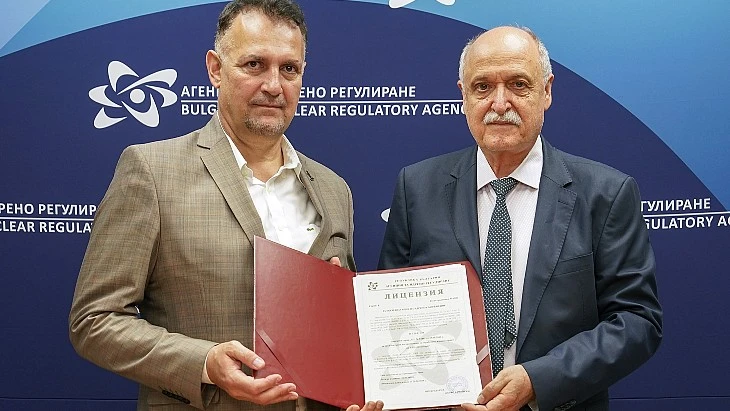
Source: https://www.world-nuclear-news.org/Articles/Kozloduy-used-fuel-storage-granted-open-ended-lice
Bulgaria's Nuclear Regulatory Agency has issued a fresh non-time-limited licence to operate the used fuel storage facility at the Kozloduy nuclear power plant.
The amended licence follows the amendments introducted in March this year to the country's Law on the Safe Use of Nuclear Energy. Instead of the licence being limited by time - notably for 10 years - it is open-ended but with a condition within the licence to carry out a safety review at least every 10 years.
The Agency said "the results of this review should justify the safe operation of the facility and are a prerequisite for the chairman of the NRA to issue an order for their approval and determine the period for carrying out the next periodic safety review".
The Kozloduy plant is in the northwest of Bulgaria on the Danube River and provides about 34% of the country's electricity. It features two Russian-designed VVER-1000 units currently in operation, which have both been through refurbishment and life extension programmes to enable operation for 60 years.
According to World Nuclear Association's Information Paper on Nuclear Power in Bulgaria, used fuel at Kozloduy is initially stored in a pool at the site which was built in 1990 and upgraded and given a new licence by the Bulgarian Nuclear Regulatory Agency in 2001. A dry used fuel storage facility was built near this at Kozloduy and opened in May 2011 with a capacity of 5200 fuel assemblies in 72 casks for storage for up to 50 years.
-
Diablo Canyon / Governor Wins Budget Battle Over $400 Million Loan For Nuclear Power Station
www.nucnet.org Diablo Canyon / Governor Wins Budget Battle Over $400 Million Loan For Nuclear Power StationCalifornia facility had been scheduled for closure in 2025
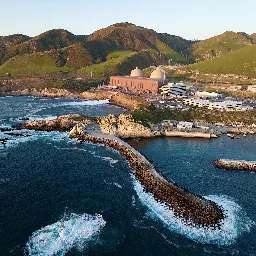
Lawmakers in California have approved a $400m (€374m) loan to keep the two-unit Diablo Canyon nuclear power station operating until 2030 after initially expressing concerns over the cost to the taxpayer.
The state’s approved includes the $400m allocation, along with a requirement for the Department of Water Resources to report on how the money will be spent.
There had been criticism and concern surrounding the loan, with some arguing that taxpayers will end up footing the bill for Diablo Canyon operator Pacific Gas & Electric and that the loan will never be paid back to the general fund, putting the burden on taxpayers.
Local press reports said the approval of the loan and the decision to keep the plant open has caused friction between governor Gavin Newsom and lawmakers, with environmental and anti-nuclear advocates warning of a growing price tag to keep the plant open and ongoing legal challenges related to the environmental impacts of extending the plant’s life.
Newsom argued that Diablo Canyon is critical for maintaining grid stability during the state’s transition to clean energy, while legislative leaders questioned the necessity and cost-effectiveness of keeping the facility open.
Diablo Canyon, California’s last commercial nuclear power station, contributes roughly 9% of the state’s energy and was initially set to close in 2025 before Newsom passed a bill to extend its life to 2030.
PG&E, meanwhile, has filed a licence renewal application with the Nuclear Regulatory Commission that could eventually see Diablo Canyon’s operational lifetime extended by up to 20 years to the mid-2040s.
The current operating licences for Units 1 and 2, both Westinghouse pressurised water reactors, were set to expire in 2024 and 2025.
In 2022 the Biden administration finalised up to $1.1bn in credit payments for the continued operation of Diablo Canyon, saying nuclear power is critical in curbing climate change and it wants to keep plants open ahead of the development of next-generation reactors. Biden wants to decarbonise the power grid by 2035.
The credits are to be paid in installments until 2026, with the amount of the annual payment to be adjusted based on factors including actual costs incurred to extend the operation of Diablo Canyon.
PG&E has been quoted in press reports as saying the federal credits will help the company pay back the state loan.
-
SMR power plant planned for Swedish site

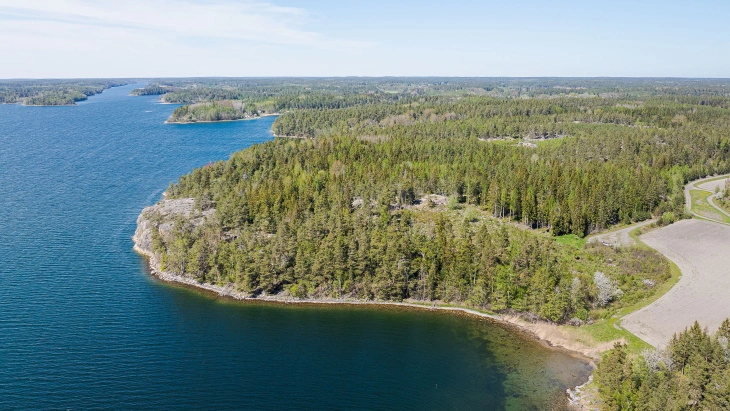
Source: https://www.world-nuclear-news.org/Articles/SMR-power-plant-planned-for-Swedish-site
Small modular reactor project development company Kärnfull Next has announced the municipality of Valdemarsvik in Östergötland county in southeastern Sweden as a new candidate site to host up to six reactors.
The company has entered into an exclusive partnership agreement with landowner Latona Group for the exploration rights for nuclear power on the site. "The ongoing study, expected to be finalised after the summer, has shown promising preliminary results leading the companies to jointly inform the municipality, site neighbours and now the general public about the plans for an SMR Campus," Kärnfull Next said.
The company noted that the property includes areas that were identified as suitable for nuclear power in studies going back as far back as the 1970s. With more than 1300 hectares in total, it said the site was appealing for co-location with 2030s energy-intensive industries, such as AI data centres. The large coastal site in Östergötland would be part of Kärnfull Next's Re:Firm South SMR programme, aiming to expand carbon-free and dispatchable energy production across southern Sweden.
"Location, topography and cooling conditions in a forward-looking municipality with extensive rural areas are examples of early indications of a positive outcome from the current stage," it said. "The project in Valdemarsvik offers significant opportunities for local job creation - a single SMR is estimated to create around 500 direct and indirect jobs per year for 70 years."
The SMR campus in Valdemarsvik is initially planned to host between four and six small light water reactors, adding between 10-15 TWh of electricity generation per year.
"We are very enthusiastic about the indications from our preliminary study in Valdemarsvik," said Kärnfull Next CEO Christian Sjölander. "This site has potential to become a key component in our programme to supply large amounts of stable and sustainable energy to regions with significant capacity needs, and create substantial economic and social benefits for the local communities."
Gustav Carp, owner of Latona Group, added: "We are very pleased to collaborate with Kärnfull Next on this exciting project. The property is likely to offer uniquely favourable conditions for nuclear power, and we look forward to being part of the development of fossil-free energy production in the region. This initiative can create significant value for Valdemarsvik and its residents."
In March 2022, Kärnfull Next signed a memorandum of understanding with GE Hitachi Nuclear Energy on the deployment of the BWRX-300 in Sweden.
Kärnfull Next has been conducting site selection and feasibility studies in several municipalities in Sweden since 2022. By establishing multiple SMR parks as part of the same programme, the company expects to achieve economies of scale in terms of technology selection, construction partners, power purchase agreements and financing partners.
In August 2023, Nyköping was announced as another candidate site within the programme. Kärnfull Next said further feasibility studies are expected "to reach sufficient maturity levels to be announced later this year".
-
Grossi praises Brazil's contributions to nuclear development


Source: https://www.world-nuclear-news.org/Articles/Grossi-praises-Brazil-s-contributions-to-nuclear-d
International Atomic Energy Agency Director General Rafael Mariano Grossi has highlighted the importance of Brazil for the global nuclear sector. During a trip to the country last week, he signed an agreement formalising the designation of Brazil's Institute for Energy and Nuclear Research as an IAEA Collaborating Centre.
"As we face the challenge of climate change, the key role of nuclear energy is set to grow and Brazil is uniquely situated to take full advantage of this," Grossi said in an address to the Chamber of Deputies, the lower house of the National Congress. "A global energy debate without Brazil makes no sense. A global nuclear debate without Brazil makes no sense."
Speaking with Minister of Mines and Energy Alexandre Silveira, Grossi said: "The IAEA encourages the continuous development of the fuel cycle in Brazil, given its potential to become a key actor in the nuclear sector production chain. These developments are crucial for strategic growth and energy security in the country."
He also addressed the Brazilian Nuclear Programme Development Committee, highlighting the critical role of nuclear energy for Brazil's economic growth and future decarbonisation plans.
During his visit, Grossi also highlighted the first-of-its-kind collaboration of the IAEA with the G20 on nuclear power. This new cooperation started this year when the Brazilian Presidency invited the IAEA to participate in the G20's Energy Transitions Working Group. The IAEA is presenting a series of briefings and reports to inform G20 members on the key role that nuclear energy can play in the energy mix and emphasising the need to accelerate financing in order to reach net zero targets.
In Rio de Janeiro, he visited the Nuclear Medicine Service at António Pedro University Hospital, where doctors explained how the IAEA's support, providing advanced equipment and training, has greatly improved early cancer detection and treatment quality.
The IAEA is also supporting the Brazilian Navy in its goals to increase medical services for remote communities located in the Amazon River delta. Two mammography machines have been installed on the ships Soares de Meirelles and Carlos Chagas, allowing these communities to have access to breast cancer diagnostic services for the first time.
Grossi also signed an agreement with Minister of Science, Technology and Innovation Luciana Santos to use nuclear science to study harmful algal blooms, microplastics, ocean acidification and more in Antarctica.
He also met with Admiral Marcos Olsen and discussions included Brazil's plans to develop naval nuclear propulsion. "The IAEA and Brazil are committed to working together for highest non-proliferation standards as Brazil advances naval nuclear propulsion plans," Grossi said.
Grossi also visited the headquarters of the Brazilian-Argentine Agency for Accounting and Control of Nuclear Materials (ABACC). "ABACC has played a key role in regional stability and its importance will only grow as Brazil embarks on naval nuclear propulsion. I am looking forward to continuing the strong cooperation between the IAEA, ABACC, Brazil and Argentina," he said.
IAEA Collaborating Centre
The IAEA's first Collaborating Centre on Nuclear Security in Latin America - the National Nuclear Energy Commission's (CNEN's) Instituto de Pesquisas Energéticas e Nucleares (IPEN-CNEN) - was also established during the trip. IPEN-CNEN, CNEN's technical-scientific unit in São Paulo, expressed interest in joining this scheme and, on 7 June, the IAEA approved the proposal for its designation.
An agreement was signed on 21 June by Grossi and CNEN President Francisco Rondinelli, formalising the designation. As an IAEA Collaborating Centre, IPEN-CNEN will assist the IAEA in activities in the areas of computer security, radiation detection and physical protection for nuclear security, for a period of four years.
"All the activities we have, of the International Atomic Energy Agency, in Brazil, need to have the indispensable cooperation of CNEN," Grossi said. "We recognise this crucial role of CNEN in the development of nuclear technology in the country. We are very grateful for this cooperation, which will continue and increase more and more."
Brazil currently has two operating nuclear power reactors and a third under construction. The country's 2050 national energy plan indicates that it could add 10 GW of nuclear in the next 30 years, which is enough to provide power for about 10 million people, with a possibility to include small modular reactors in its energy mix after 2030.
